British Columbia, located in the westernmost province of Canada, is a region known for its diverse and stunning natural environment. With a vast array of landscapes ranging from rugged mountains to lush rainforests, British Columbia is home to a variety of unique flora and fauna.
The region experiences a temperate climate, with mild winters and warm summers, making it an ideal destination for outdoor enthusiasts year-round. From grizzly bears to bald eagles, British Columbia is home to a plethora of wildlife, making it a prime location for nature lovers and wildlife enthusiasts alike.
With its breathtaking scenery and abundant wildlife, British Columbia is a must-visit destination for anyone seeking to experience the beauty of Canada’s natural environment. .
Types Of Ants In British Columbia, Canada
The Types Of Ants In British Columbia, Canada are listed here: Funnel Ants, Rover Ants, Carpenter And Sugar Ants, Dolly Ants, Wood Ants, Formicoxenus, Harpagoxenus, Moisture Ants, Leptothorax, Velvety Tree Ants, Manica, Trailing Pharaoh And Timid Ants, Myrmecocystus, Furrowed Ants, Big Headed Ants, Typical American Harvester Ants, Amazon Ants, Winter Ants, Hairy Curltail Ants, Fire Ants, Leaf-Litter Ants, Vampire Ants, Tapinoma, Slave-Making Ants, Funnel Ants, Winnow Ants, Hairless Rover Ants, Hercules Ants, Carpenter And Sugar Ants, Carpenter And Sugar Ants, Carpenter And Sugar Ants, Carpenter Ants, Black Carpenter Ants, Carpenter And Sugar Ants, Wood Ants, Wood Ants, Silver Ants, Blood-Red Field Ants, Wood Ants, Wood Ants, Wood Ants, Silky Ants, Wood Ants, Wood Ants, Fuzzy Mount Ants, Wood Ants, Red-Bearded Mound Ants, Western Thatching Ants, Northern Red Wood Ants, Wood Ants, Wood Ants, Wood Ants, Wood Ants, Formicoxenus Diversipilosus, Cornfield Ants, Wide-Legged Citronella Ants, New World Fuzz Ants, Labour Day Ants, Black Garden Ants, Moisture Ants, Moisture Ants, Moisture Ants, Yellow Shadow Ants, Mossy Thin Ants, Leptothorax Muscorum Uvicensis, Velvety Tree Ants, Manica Hunteri, Manica Invidia, Furrowed Ants, Furrowed Ants, Furrowed Ants, Incomplete Fire Ants, Furrowed Ants, Furrowed Ants, Big Headed Ants, Typical American Harvester Ants, Western Amazon Ants, Diecks Slender Ants, Leaf-Litter Ants, Vampire Ants, Odorous House Ants, Slave-Making Ants, Slave-Making Ants, Slave-Making Ants.
If you’ve found some other ants in this region, contact us, and we will add them to the list!
1) Funnel Ants, Aphaenogaster
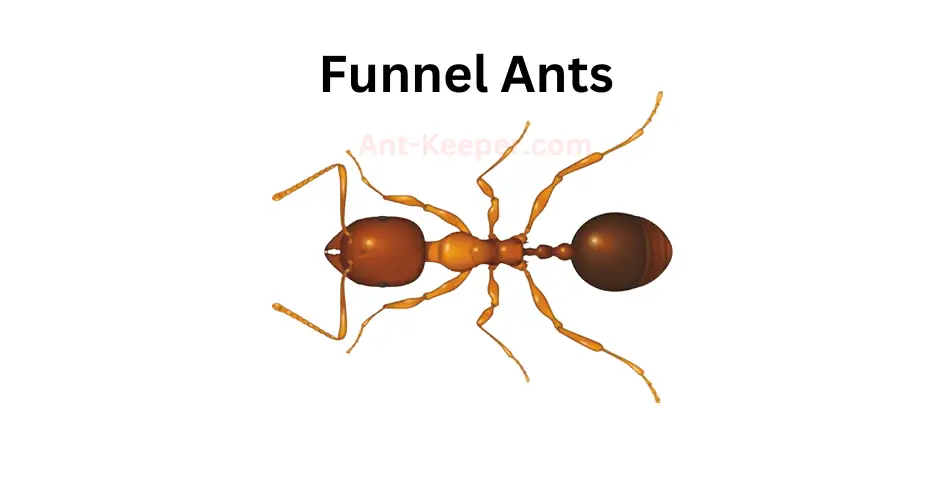
The Funnel Ants, also known as Aphaenogaster ants, are a species of ants that are commonly found in various habitats around the world.
These ants are known for their unique nesting behavior, where they construct funnel-shaped nests that are typically located in soil or leaf litter.
The Funnel Ants are relatively small in size, with workers measuring between 3-5mm in length.
They are typically reddish-brown in color and have a slender body shape.
These ants are known for their strong mandibles, which they use to collect and transport food back to their nests.
One of the most interesting aspects of the Funnel Ants is their nesting behavior.
These ants construct funnel-shaped nests that are typically located in soil or leaf litter.
The entrance to the nest is narrow and funnel-shaped, which helps to protect the colony from predators and other threats.
Inside the nest, the ants create a series of chambers and tunnels that are used for different purposes, such as storing food, caring for the brood, and housing the queen.
The Funnel Ants are omnivorous, meaning that they feed on both plant and animal matter.
They are known to collect a wide variety of food items, including seeds, insects, and other small invertebrates.
These ants are also known to tend to aphids, which they use for their honeydew secretion.
Overall, the Funnel Ants are a fascinating species of ants that are known for their unique nesting behavior and omnivorous diet.
They play an important role in their ecosystems, helping to control populations of other insects and contributing to nutrient cycling in the soil.
2) Rover Ants, Brachymyrmex
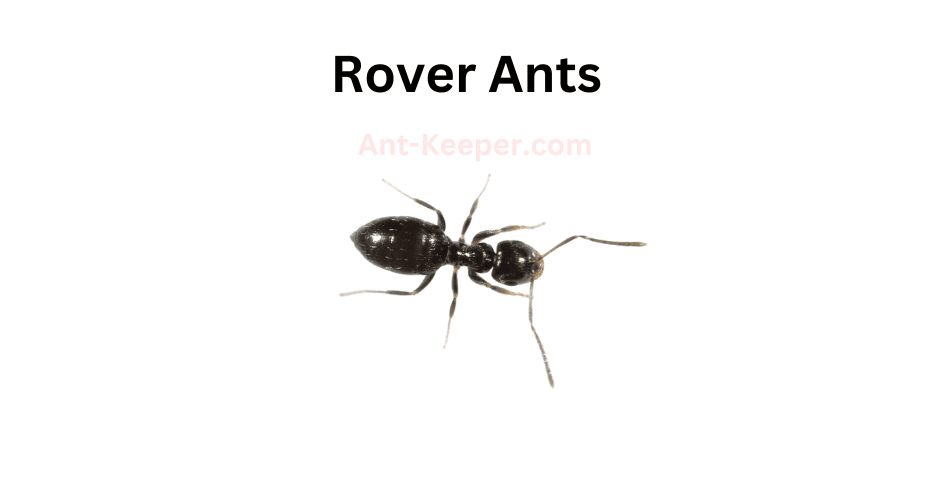
Rover ants, also known as Brachymyrmex spp., are a species of small, dark-colored ants that are commonly found in urban and suburban areas.
These ants are known for their ability to quickly move their nests from one location to another, hence their name "rover ants."
Rover ants are typically between 1.5 and 2.5 millimeters in length and have a dark brown or black coloration.
They have a slender body with a distinct waist and long, thin legs.
These ants are known for their aggressive behavior towards other ant species and will often invade and take over their nests.
Rover ants are omnivorous and will feed on a variety of food sources, including insects, sweets, and plant material.
They are also known to be attracted to human food and can become a nuisance in homes and other buildings.
One unique characteristic of rover ants is their ability to form "supercolonies." These supercolonies can consist of multiple nests and can span large areas.
This behavior allows rover ants to quickly adapt to changing environments and find new food sources.
Overall, rover ants are a common and adaptable species that can be found in many different environments.
While they can be a nuisance in homes and other buildings, they play an important role in the ecosystem as scavengers and predators of other insects.
3) Carpenter And Sugar Ants, Camponotus

Carpenter ants and sugar ants are two common species of ants found in many regions of the world.
Carpenter ants are known for their ability to excavate wood and create nests within it.
They are typically larger in size than sugar ants and have a black or dark brown coloration.
Carpenter ants are also known for their strong mandibles, which they use to chew through wood and other materials.
Sugar ants, on the other hand, are smaller in size and have a yellow or brown coloration.
They are named for their preference for sugary foods and are often found in kitchens and other areas where food is stored.
Sugar ants are also known for their ability to form large colonies, with thousands of individual ants working together to gather food and care for their young.
Both carpenter ants and sugar ants play important roles in their ecosystems.
Carpenter ants help to break down dead wood and other plant material, which helps to recycle nutrients back into the soil.
Sugar ants help to disperse seeds and pollinate plants, which helps to maintain healthy ecosystems.
However, both species can also be pests when they invade human homes and buildings.
Carpenter ants can cause damage to wooden structures, while sugar ants can contaminate food and be a nuisance to homeowners.
It is important to take steps to prevent ant infestations and to control them if they do occur, in order to protect both human health and the health of the environment.
4) Dolly Ants, Dolichoderus
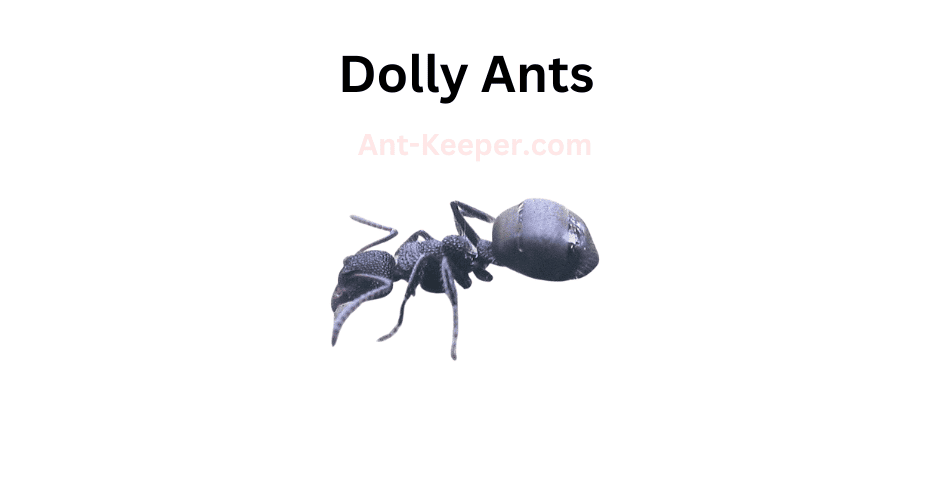
Dolly Ants, also known as Dolichoderus spp., are a species of ant that belong to the family Formicidae.
These ants are known for their distinctive elongated heads and bodies, which give them a unique appearance compared to other ant species.
Dolly Ants are typically found in forested areas, where they build their nests in soil or under rocks.
They are known to be highly social insects, living in large colonies that can contain thousands of individuals.
Within these colonies, there is a strict division of labor, with different ants taking on specific roles such as foraging, caring for the young, and defending the colony.
One interesting aspect of Dolly Ant behavior is their use of chemical communication.
These ants use pheromones to communicate with each other, leaving trails of scent that other ants can follow to locate food sources or to find their way back to the nest.
They also use pheromones to signal danger, which can trigger a coordinated response from the colony to defend against predators.
Dolly Ants are omnivorous, feeding on a variety of foods including insects, nectar, and plant sap.
They are also known to have a mutualistic relationship with certain plant species, where they protect the plants from herbivores in exchange for a source of food.
Overall, Dolly Ants are a fascinating species of ant with unique physical and behavioral characteristics.
Their social structure and use of chemical communication make them an important subject of study for researchers interested in understanding the behavior of social insects.
5) Wood Ants, Formica

Wood ants, also known as carpenter ants, are a species of ant that belong to the genus Camponotus.
They are widely distributed throughout the world and are commonly found in forests and woodlands.
These ants are known for their ability to excavate wood and create nests inside trees, logs, and other wooden structures.
Wood ants are typically large in size, with workers ranging from 6 to 13 millimeters in length.
They are usually black or brown in color and have a smooth, shiny exoskeleton.
These ants have strong mandibles that they use to chew through wood and defend their nests.
Wood ants are social insects that live in colonies consisting of a queen, workers, and soldiers.
The queen is responsible for laying eggs, while the workers and soldiers are responsible for maintaining the nest and protecting it from predators.
These ants communicate with each other using chemical signals called pheromones.
Wood ants are omnivores and feed on a variety of food sources, including insects, honeydew, and plant sap.
They are also known to scavenge for food and will sometimes raid the nests of other ant species.
Despite their ability to excavate wood, wood ants are not considered pests.
In fact, they play an important role in forest ecosystems by helping to decompose dead wood and recycle nutrients.
They also serve as a food source for many other animals, including birds, mammals, and other insects.
Overall, wood ants are fascinating creatures that have adapted to live in a unique habitat.
Their ability to excavate wood and create nests inside trees is a testament to their ingenuity and resourcefulness.
6) Formicoxenus
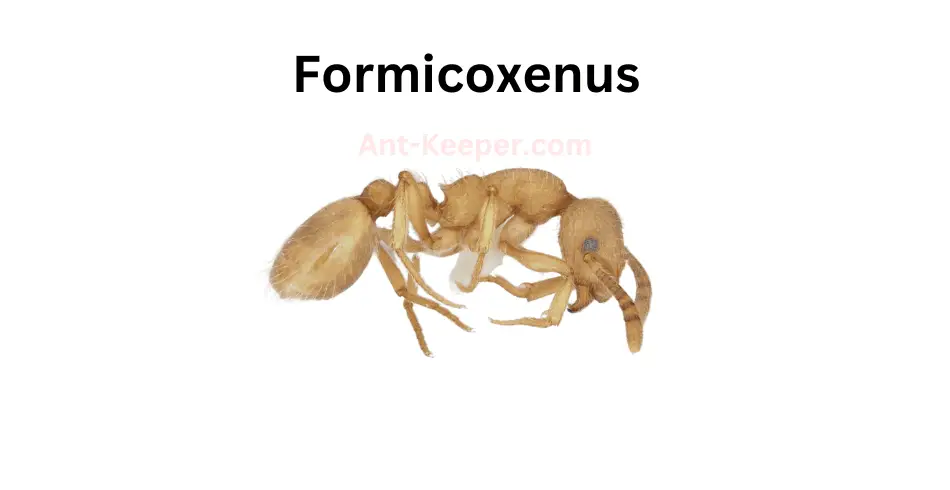
Formicoxenus is a genus of ants belonging to the subfamily Myrmicinae.
The ants in this genus are small in size, measuring between 1.5 to 3 millimeters in length.
They are known for their distinctive morphology, which includes a narrow waist and a large head with long mandibles.
Formicoxenus ants are typically found in forested areas, where they live in small colonies under rocks, logs, or in leaf litter.
They are known to be highly specialized, with each species having a specific host ant species that they parasitize.
The Formicoxenus ants are social parasites, meaning that they rely on their host ants for food and shelter.
The reproductive strategy of Formicoxenus ants is unique.
The queen ant will infiltrate the host colony and kill the resident queen.
She will then lay her eggs in the host colony, which will be raised by the host workers.
The Formicoxenus larvae will then feed on the host ant larvae and pupae, ensuring their survival.
Formicoxenus ants are important members of forest ecosystems, as they play a role in controlling the population of their host ants.
They are also important indicators of forest health, as their presence can indicate the presence of healthy forest ecosystems.
7) Harpagoxenus
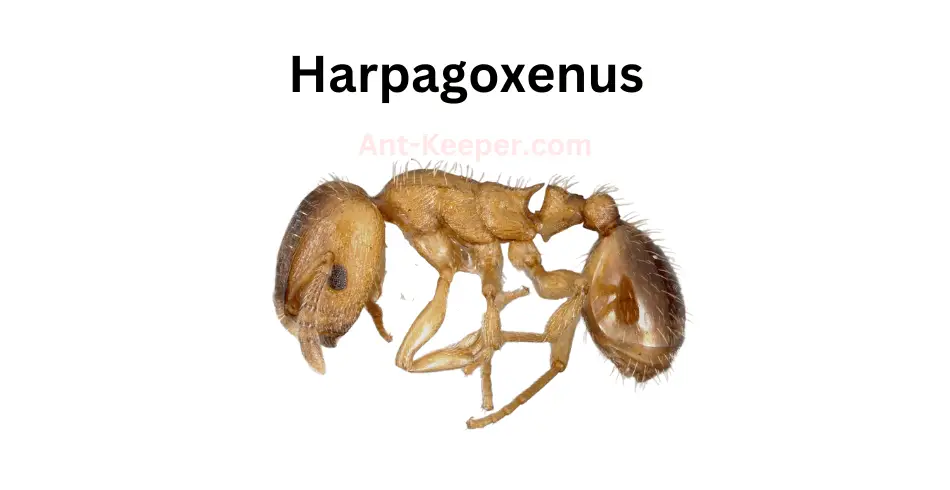
Harpagoxenus is a genus of ants belonging to the subfamily Myrmicinae.
The species Harpagoxenus can be identified by its small size, measuring only a few millimeters in length.
They have a dark brown to black coloration and a slender body shape.
Harpagoxenus ants are known for their unique social behavior.
They are considered to be social parasites, meaning they rely on other ant species to raise their young.
Harpagoxenus queens will invade the nests of other ant species and lay their eggs among the host colony's brood.
The Harpagoxenus larvae will then be fed and cared for by the host workers until they reach adulthood.
Once the Harpagoxenus workers emerge, they will begin to take over the host colony.
They will kill the host queen and force the remaining workers to care for their young.
The Harpagoxenus workers will also take over the food resources of the host colony, ensuring their own survival.
Harpagoxenus ants are found in a variety of habitats, including forests, grasslands, and deserts.
They are most commonly found in areas with high ant diversity, as they rely on other ant species for their survival.
Overall, Harpagoxenus ants are fascinating creatures with unique social behavior.
Their reliance on other ant species for survival makes them an important part of the ecosystem and highlights the complex interactions between different species in nature.
8) Moisture Ants, Lasius
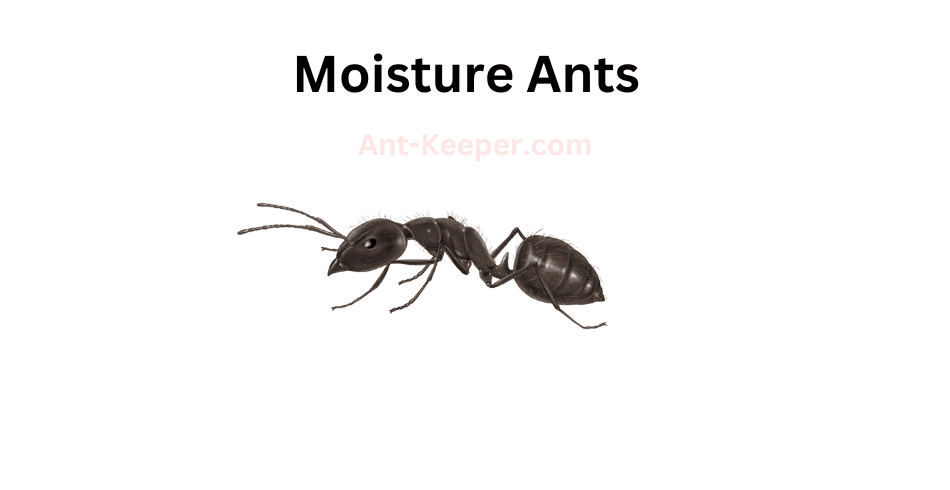
Moisture ants are a type of ant that is commonly found in damp environments.
They are known for their ability to thrive in areas with high levels of moisture, such as in rotting wood or in soil that is constantly moist.
These ants are typically small in size, measuring only a few millimeters in length, and are usually yellow or brown in color.
Moisture ants are social insects that live in colonies, with each colony consisting of a queen, workers, and soldiers.
The queen is responsible for laying eggs, while the workers and soldiers are responsible for maintaining the colony and protecting it from predators.
One of the unique characteristics of moisture ants is their ability to create satellite colonies.
These colonies are established in nearby locations and are connected to the main colony by a network of tunnels.
This allows the ants to expand their territory and increase their chances of survival.
Moisture ants are also known for their ability to control the moisture levels in their environment.
They do this by building intricate nests that are designed to regulate the humidity levels inside.
This is important for the survival of the colony, as too much moisture can lead to the growth of harmful fungi and bacteria.
Overall, moisture ants are fascinating creatures that have adapted to thrive in environments that would be inhospitable to many other species.
Their ability to control moisture levels and create satellite colonies makes them a formidable force in their ecosystem.
9) Leptothorax
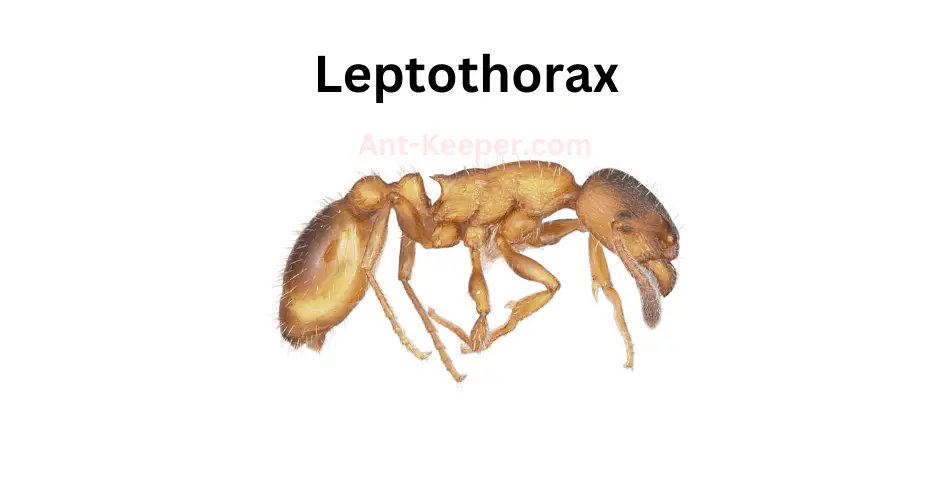
Leptothorax is a genus of ants that belongs to the family Formicidae.
These ants are small in size, measuring between 2 to 4 millimeters in length.
They are commonly found in forests, grasslands, and other natural habitats.
Leptothorax ants are known for their social behavior, as they live in colonies that can range from a few dozen to several hundred individuals.
These ants have a hierarchical social structure, with a queen ant at the top and worker ants at the bottom.
The queen ant is responsible for laying eggs, while the worker ants take care of the young, gather food, and defend the colony from predators.
One interesting feature of Leptothorax ants is their ability to form temporary colonies with other ant species.
This behavior is known as "temporary social parasitism," and it allows Leptothorax ants to benefit from the resources of other ant colonies without having to invest in their own colony infrastructure.
Leptothorax ants are also known for their ability to navigate through complex environments.
They use a combination of visual cues and chemical signals to find their way back to the colony after foraging for food.
Overall, Leptothorax ants are fascinating creatures that play an important role in their ecosystems.
Their social behavior and navigational abilities make them a subject of interest for scientists studying animal behavior and ecology.
10) Velvety Tree Ants, Liometopum
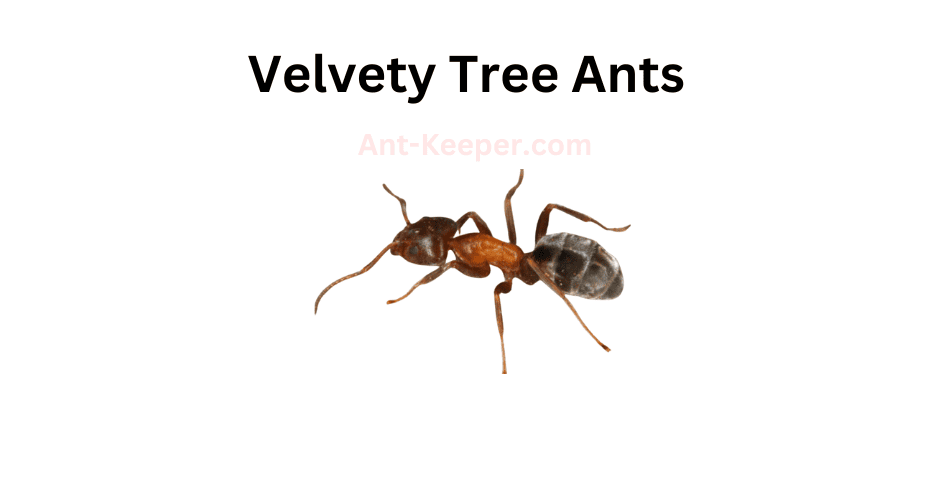
Velvety Tree Ants, also known as Liometopum occidentale, are a species of ant that belong to the family Formicidae.
These ants are commonly found in forested areas and are known for their unique appearance and behavior.
Velvety Tree Ants are typically black or dark brown in color and have a velvety texture to their bodies.
They are relatively large ants, with workers measuring up to 10mm in length.
These ants are also known for their distinctive mandibles, which are used for cutting and carrying food.
One of the most interesting aspects of Velvety Tree Ants is their nesting behavior.
These ants build large nests in trees, which can be up to several meters in diameter.
The nests are made from a combination of plant material and the ants' own saliva, which creates a strong and durable structure.
Velvety Tree Ants are omnivorous, meaning that they eat both plant and animal matter.
They are known to feed on a variety of insects, as well as honeydew produced by aphids and other insects.
These ants are also known to cultivate fungi within their nests, which they use as a food source.
In terms of their ecological role, Velvety Tree Ants are important predators and scavengers in forest ecosystems.
They help to control populations of other insects and contribute to nutrient cycling by breaking down organic matter.
Overall, Velvety Tree Ants are a fascinating and important species of ant that play an important role in forest ecosystems.
Their unique appearance and behavior make them a popular subject of study for scientists and nature enthusiasts alike.
11) Manica
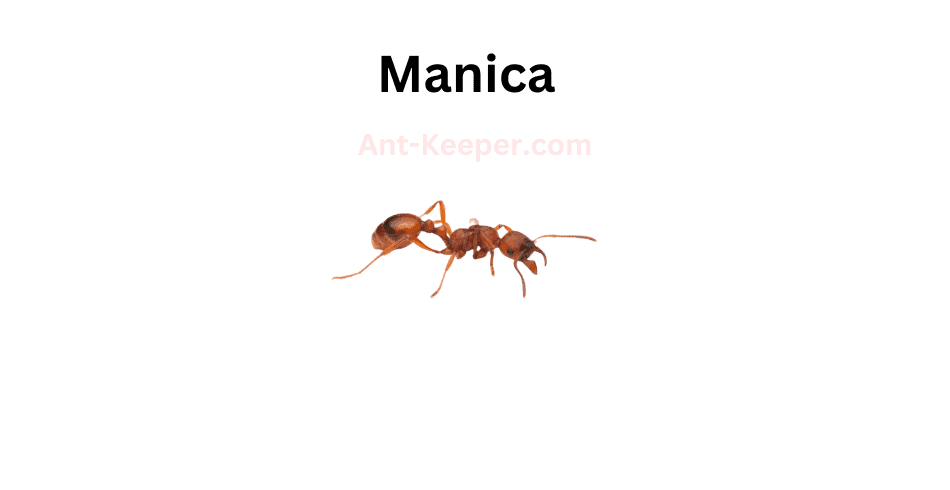
The Manicabe ant, also known as the scientific name Manica rubida, is a species of ant that belongs to the Formicidae family.
These ants are known for their reddish-brown color and their aggressive behavior towards other ant species.
Manicabe ants are typically found in forested areas and are known to build their nests in soil or under rocks.
They are also known to be highly territorial and will defend their nests aggressively against any intruders.
One interesting behavior of the Manicabe ant is their ability to form large raiding parties.
These raids are typically carried out against other ant species and are known to be highly coordinated and efficient.
The ants will work together to overwhelm their opponents and steal their food and resources.
Manicabe ants are also known for their unique communication system.
They use a combination of chemical signals and physical cues to communicate with each other and coordinate their activities.
This communication system allows them to work together effectively and efficiently, even in large groups.
Overall, the Manicabe ant is a fascinating species that exhibits a wide range of interesting behaviors and adaptations.
Their aggressive nature and unique communication system make them a fascinating subject for scientific study.
12) Trailing Pharaoh And Timid Ants, Monomorium

The Trailing Pharaoh ant, also known as the Monomorium pharaonis, is a small, reddish-brown ant species that is commonly found in urban areas.
These ants are known for their ability to form large colonies, which can consist of thousands of individuals.
One interesting behavior of the Trailing Pharaoh ant is their tendency to trail behind other ants.
This behavior is thought to be a form of communication, as the trailing ants are able to follow the scent trail left by the leading ants.
This behavior is also used to locate food sources, as the trailing ants are able to follow the trail to the source of the food.
In contrast to the bold behavior of the Trailing Pharaoh ant, the Timid ant, also known as the Temnothorax species, is a much more cautious species.
These ants are small and brown, and are often found in wooded areas.
They are known for their timid behavior, and will often retreat into their nests when threatened.
Despite their timid nature, the Timid ant is still able to form large colonies.
They are also known for their ability to adapt to changing environments, and can be found in a variety of habitats, including forests, meadows, and even urban areas.
Overall, both the Trailing Pharaoh ant and the Timid ant are fascinating species that demonstrate unique behaviors and adaptations.
By studying these ants, scientists can gain a better understanding of the complex social behaviors and ecological roles of ants in their respective environments.
13) Myrmecocystus
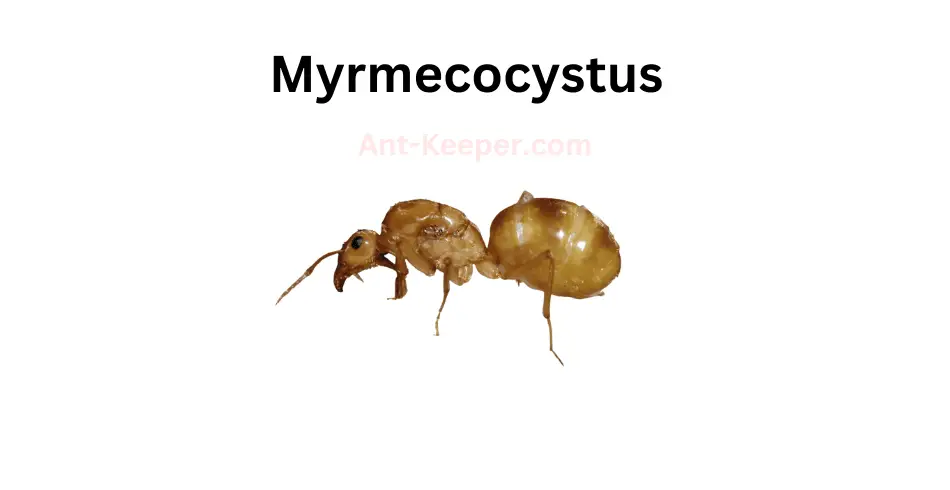
Myrmecocystus is a genus of ants that belongs to the family Formicidae.
These ants are commonly known as honey pot ants due to their unique ability to store food in their bodies.
The species Myrmecocystus is known for its distinctive appearance, with workers ranging in size from 3 to 7 millimeters in length and queens measuring up to 15 millimeters.
The honey pot ants have a specialized caste system, with workers responsible for foraging and storing food in their enlarged abdomens.
These workers can store up to several milliliters of liquid food, which they regurgitate to feed other members of the colony during times of scarcity.
The stored food also serves as a reserve for the colony during the dry season.
Myrmecocystus ants are found in arid and semi-arid regions, where they build their nests in sandy or rocky soil.
The nests can be shallow or deep, depending on the species, and are often marked by a small entrance hole.
The ants are known for their aggressive behavior and will defend their nests fiercely against intruders.
The honey pot ants play an important role in their ecosystem, as they are a food source for many other animals, including birds, reptiles, and mammals.
They also help to aerate the soil and distribute nutrients through their foraging activities.
Overall, Myrmecocystus ants are fascinating creatures with unique adaptations that allow them to thrive in harsh environments.
Their ability to store food in their bodies is a remarkable example of how evolution has shaped the behavior and physiology of these insects.
14) Furrowed Ants, Myrmica

Furrowed ants, also known as Pheidole ruginoda, are a species of ant that belong to the family Formicidae.
These ants are commonly found in various habitats such as forests, grasslands, and deserts.
They are known for their distinctive appearance, with a furrowed head and thorax, and a smooth and shiny abdomen.
Furrowed ants are social insects that live in colonies, which can range in size from a few hundred to several thousand individuals.
The colony is typically headed by a queen ant, whose primary role is to lay eggs.
The workers, which are sterile females, are responsible for foraging, nest maintenance, and caring for the young.
These ants are omnivorous, meaning they feed on both plant and animal matter.
Their diet consists of seeds, insects, and other small invertebrates.
They are also known to tend to aphids, which produce a sugary substance that the ants feed on.
Furrowed ants are known for their aggressive behavior, and will defend their colony fiercely against intruders.
They have been observed engaging in territorial battles with other ant species, and will even attack larger insects such as grasshoppers and beetles.
Overall, furrowed ants are an important part of many ecosystems, playing a crucial role in seed dispersal and soil aeration.
Their unique appearance and behavior make them a fascinating subject for study and observation.
15) Big Headed Ants, Pheidole

Big Headed Ants, also known as Pheidole megacephala, are a species of ant that belong to the family Formicidae.
These ants are known for their distinctive large heads, which are used for defense and communication within their colonies.
Big Headed Ants are typically found in tropical and subtropical regions, where they build their nests in soil, leaf litter, and other organic matter.
They are omnivorous, feeding on a variety of insects, seeds, and other small organisms.
One of the most interesting aspects of Big Headed Ants is their social behavior.
They live in large colonies, with a queen ant at the center of the hierarchy.
The queen is responsible for laying eggs, while the other ants in the colony perform various tasks such as foraging for food, caring for the young, and defending the colony from predators.
Big Headed Ants are also known for their ability to displace other ant species in their habitats.
They are aggressive and have been known to attack and kill other ants, as well as compete with them for resources.
Despite their aggressive behavior, Big Headed Ants are not considered a major pest species.
However, their ability to displace other ant species and their potential impact on native ecosystems make them an important species to study and monitor.
16) Typical American Harvester Ants, Pogonomyrmex
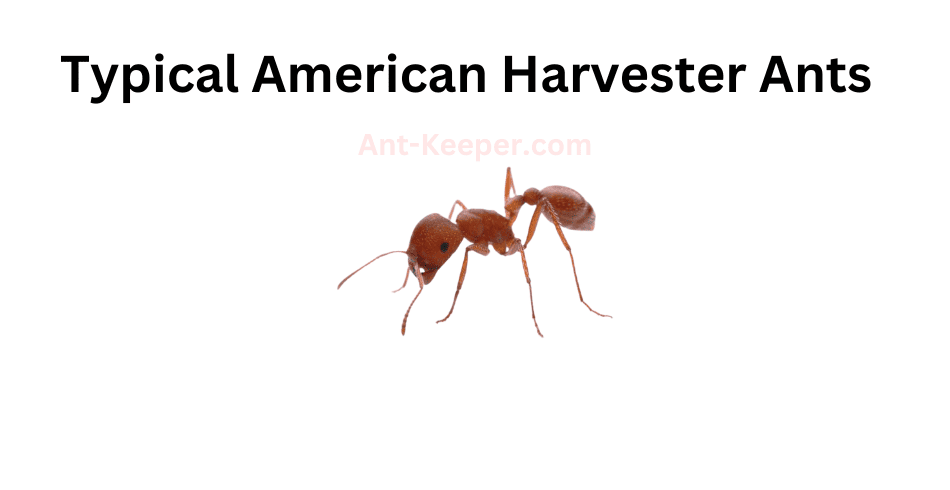
The typical American Harvester Ant (Pogonomyrmex spp.) is a species of ant that belongs to the family Formicidae.
These ants are commonly found in grasslands and deserts throughout North America.
They are known for their impressive ability to harvest and store seeds, which they use as a primary food source.
The American Harvester Ant is a medium-sized ant, with workers ranging in size from 4 to 8 mm in length.
They have a distinctive reddish-brown coloration and a large head with powerful mandibles.
These ants are highly social and live in large colonies, with a single queen responsible for laying eggs and producing new workers.
One of the most notable characteristics of the American Harvester Ant is their impressive seed harvesting behavior.
These ants use their powerful mandibles to cut and collect seeds from nearby plants, which they then carry back to their nest.
Once inside the nest, the ants store the seeds in underground chambers, where they can be accessed as needed.
In addition to their seed harvesting behavior, American Harvester Ants are also known for their aggressive defense of their nests.
These ants will fiercely defend their colony against any perceived threat, using their powerful mandibles to bite and sting intruders.
Overall, the American Harvester Ant is a fascinating species of ant with unique behaviors and adaptations that allow them to thrive in their native habitats.
Their impressive seed harvesting abilities and aggressive defense strategies make them an important part of many North American ecosystems.
17) Amazon Ants, Polyergus
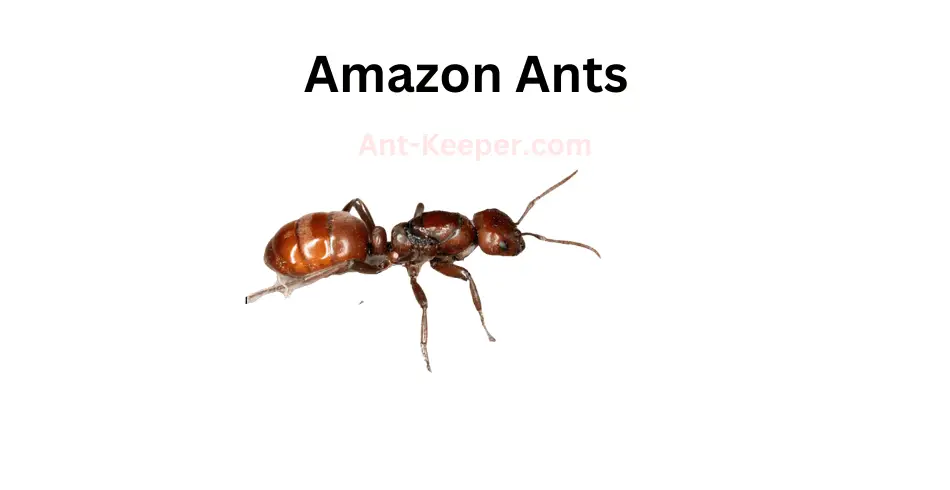
The Amazon Ant, also known as the Polyergus breviceps, is a species of ant that belongs to the Formicidae family.
These ants are known for their unique behavior of raiding other ant colonies and stealing their brood to raise as their own.
The Amazon Ants are typically black or dark brown in color and have a slender body with long legs.
They are relatively small in size, with workers measuring around 4-5 mm in length.
The queen ants are slightly larger, measuring around 7-8 mm in length.
These ants are social insects and live in large colonies that can consist of thousands of individuals.
The colonies are usually divided into different castes, including workers, soldiers, and reproductive ants.
The workers are responsible for foraging, caring for the brood, and maintaining the nest, while the soldiers defend the colony from predators.
One of the most interesting aspects of the Amazon Ants is their unique behavior of raiding other ant colonies.
They do this by sending out a group of specialized workers, known as raiders, to infiltrate the target colony.
The raiders then steal the brood of the target colony and bring it back to their own nest.
Once the stolen brood hatches, the Amazon Ants use it to increase their own workforce.
The Amazon Ants are also known for their symbiotic relationship with a species of butterfly known as the Maculinea rebeli.
The butterfly larvae feed on the brood of the Amazon Ants, but in return, they secrete a substance that makes the ants more aggressive and better at raiding other colonies.
Overall, the Amazon Ants are fascinating creatures with unique behaviors and adaptations that allow them to thrive in their environment.
18) Winter Ants, Prenolepis

Winter ants, also known as Formica exsectoides, are a species of ant that are commonly found in temperate regions.
These ants are known for their ability to survive harsh winter conditions, which is where they get their name from.
Winter ants are typically black or dark brown in color and can range in size from 4 to 8 millimeters in length.
They are social insects and live in large colonies that can contain thousands of individuals.
These colonies are typically located underground, where the ants construct elaborate tunnels and chambers.
One of the most interesting things about winter ants is their ability to survive the cold winter months.
Unlike many other ant species, winter ants do not hibernate during the winter.
Instead, they have developed a number of adaptations that allow them to survive in the cold.
One of these adaptations is the ability to regulate their body temperature.
Winter ants are able to generate heat by shivering their muscles, which allows them to maintain a temperature of around 25 degrees Celsius even when the outside temperature drops below freezing.
Winter ants also have a unique diet that helps them survive the winter.
They feed on the honeydew produced by aphids, which is a sugary substance that provides them with the energy they need to survive.
Overall, winter ants are a fascinating species of ant that have adapted to survive in some of the harshest conditions on earth.
Their ability to regulate their body temperature and feed on a unique diet make them a truly remarkable species.
19) Hairy Curltail Ants, Proceratium
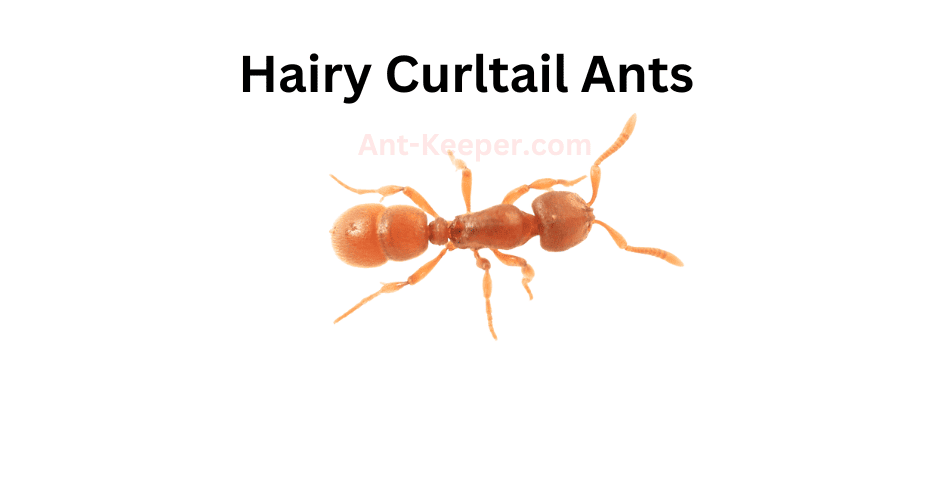
The Hairy Curltail Ant (Camponotus pilicornis) is a species of ant belonging to the genus Camponotus.
These ants are known for their distinctive hairy appearance, which covers their entire body.
The hairs on their body are long and curly, giving them a unique and striking appearance.
Hairy Curltail Ants are typically found in forested areas, where they build their nests in dead wood or under rocks.
They are known to be highly territorial and will aggressively defend their nests against intruders.
These ants are also known to be omnivorous, feeding on a variety of food sources including insects, nectar, and honeydew.
The Hairy Curltail Ant is a relatively large ant species, with workers measuring between 6-12mm in length.
The queen ant is even larger, measuring up to 15mm in length.
These ants are also known for their strong mandibles, which they use to defend their nests and capture prey.
One interesting aspect of the Hairy Curltail Ant is their ability to communicate with each other through the use of pheromones.
These chemical signals are used to mark trails, identify nestmates, and coordinate foraging activities.
Overall, the Hairy Curltail Ant is a fascinating species of ant with a unique appearance and interesting behaviors.
Their presence in forested areas can have important ecological implications, as they play a role in the ecosystem as both predators and scavengers.
20) Fire Ants, Solenopsis
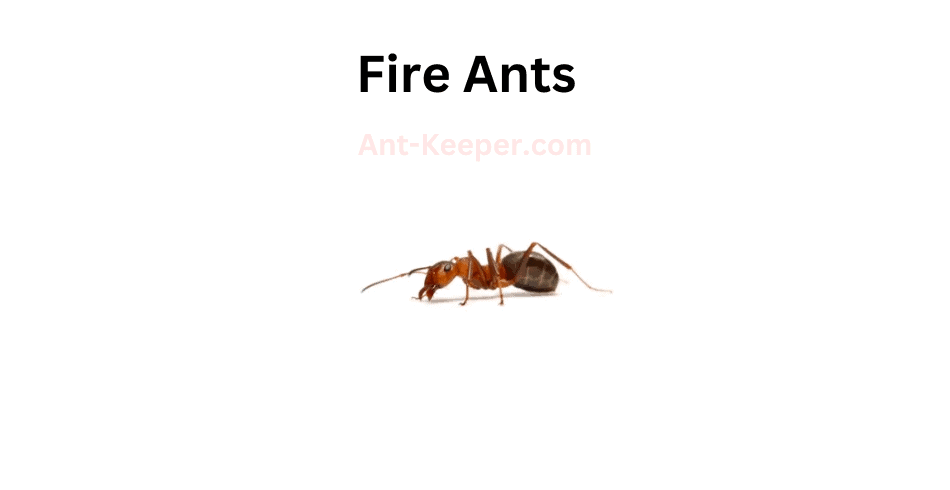
Fire ants are a type of ant that belongs to the Solenopsis genus.
They are known for their reddish-brown color and their aggressive behavior.
Fire ants are social insects that live in colonies, which can range in size from a few hundred to several thousand individuals.
Fire ants are omnivorous and feed on a variety of foods, including insects, seeds, and other small animals.
They are also known to scavenge for food and will often invade other ant colonies to steal their resources.
One of the most distinctive features of fire ants is their ability to sting.
They have a stinger located at the end of their abdomen, which they use to inject venom into their prey or enemies.
Fire ant stings can be painful and can cause an allergic reaction in some people.
Fire ants are also known for their ability to build large mounds, which can reach heights of up to 18 inches.
These mounds are made of soil and are used as a nesting site for the colony.
Fire ants are considered to be an invasive species in many parts of the world, as they can cause damage to crops and wildlife.
They are also a nuisance to humans, as their stings can be painful and their mounds can be unsightly.
Overall, fire ants are fascinating insects that have adapted to thrive in a variety of environments.
While they can be a nuisance, they are an important part of the ecosystem and play a vital role in controlling insect populations.
21) Leaf-Litter Ants, Stenamma

Leaf-litter ants are a group of ants that are commonly found in forested areas around the world.
They are known for their ability to live and forage in the leaf litter layer of the forest floor, where they play an important role in nutrient cycling and soil health.
Leaf-litter ants are typically small in size, ranging from 1-5mm in length.
They are often reddish-brown or black in color, and have a slender, elongated body shape.
These ants are social insects, living in colonies that can range in size from a few dozen to several thousand individuals.
One of the key characteristics of leaf-litter ants is their ability to forage for food in the leaf litter layer.
They are known to feed on a variety of organic matter, including dead insects, fungi, and plant material.
Leaf-litter ants are also important decomposers, breaking down organic matter and returning nutrients to the soil.
In addition to their role in nutrient cycling, leaf-litter ants also play an important role in the ecosystem as prey for other animals.
They are a food source for a variety of predators, including birds, reptiles, and other insects.
Overall, leaf-litter ants are an important and fascinating group of insects that play a critical role in maintaining the health and functioning of forest ecosystems around the world.
22) Vampire Ants, Stigmatomma
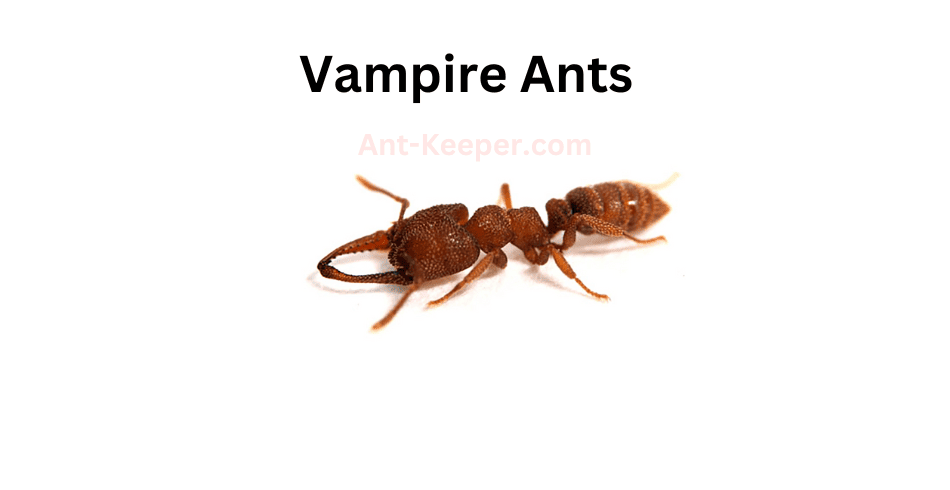
Vampire ants, also known as blood-sucking ants, are a species of ants that feed on the blood of other insects.
These ants are known for their unique feeding behavior, which involves biting into the exoskeleton of their prey and then sucking out their blood.
Vampire ants are typically found in tropical and subtropical regions, where they live in colonies of up to several thousand individuals.
They are known for their aggressive behavior and will attack other insects, including larger prey such as grasshoppers and caterpillars.
One of the most interesting aspects of vampire ants is their ability to adapt to their environment.
In some cases, these ants have been known to feed on the blood of their own colony members when other sources of food are scarce.
Vampire ants are also known for their unique physical characteristics.
They have long, curved mandibles that are used to bite into the exoskeleton of their prey.
They also have specialized mouthparts that allow them to suck out the blood of their victims.
Despite their aggressive behavior and blood-sucking tendencies, vampire ants play an important role in their ecosystem.
They help to control the populations of other insects and contribute to the overall balance of their environment.
Overall, vampire ants are a fascinating species of ants that have adapted to their environment in unique and interesting ways.
Their behavior and physical characteristics make them a subject of interest for scientists and nature enthusiasts alike.
23) Tapinoma

Tapinoma is a genus of ants that belongs to the family Formicidae.
The species Tapinoma is a small ant that measures about 2-3 mm in length.
They are commonly found in urban and suburban areas, and are known to invade homes and buildings in search of food and shelter.
Tapinoma ants are light brown in color and have a slender body with long legs.
They have a distinctively shaped head that is wider than their thorax, and they possess a pair of antennae that are bent at a right angle.
These ants are known for their ability to form large colonies, which can consist of thousands of individuals.
Tapinoma ants are omnivorous and feed on a variety of food sources, including insects, nectar, and honeydew.
They are also known to scavenge for food in garbage cans and other waste areas.
These ants are attracted to sweet and sugary substances, and will often invade kitchens and pantries in search of food.
Tapinoma ants are not known to be aggressive towards humans, but they can become a nuisance when they invade homes and buildings.
They are known to build their nests in wall voids, under floors, and in other hidden areas.
If left unchecked, these ants can cause damage to structures and can contaminate food sources.
Overall, Tapinoma ants are a common pest in many parts of the world.
While they are not harmful to humans, they can be a nuisance when they invade homes and buildings.
Proper pest control measures can help to prevent infestations and keep these ants at bay.
24) Slave-Making Ants, Temnothorax
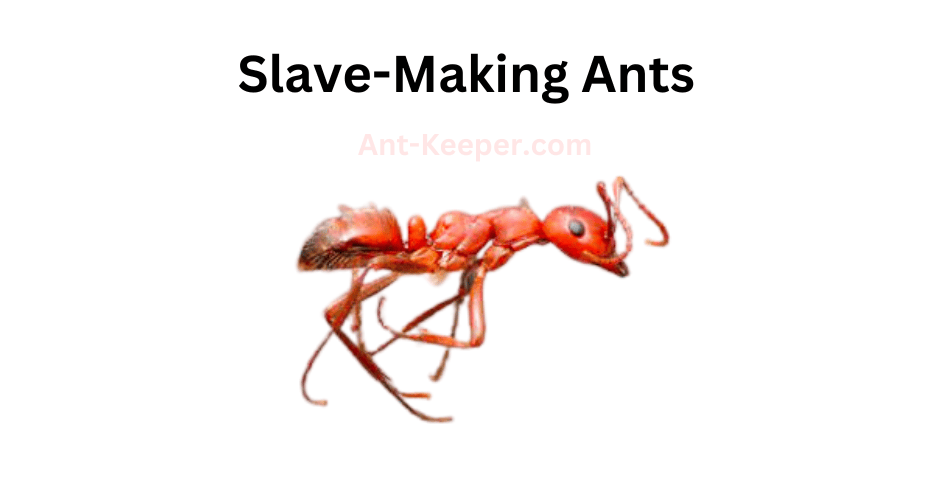
The Slave-Making Ants, also known as Dulosis ants, are a group of social insects that engage in a unique behavior of raiding and enslaving other ant colonies.
These ants belong to the subfamily Formicinae and are found in various parts of the world.
The Slave-Making Ants have a complex social structure, with a queen, workers, and soldiers.
The queen is responsible for laying eggs, while the workers and soldiers carry out various tasks such as foraging, nest building, and defense.
However, unlike other ant species, the Slave-Making Ants do not rely solely on their own colony for survival.
Instead, these ants raid nearby colonies of other ant species, using their superior strength and numbers to overpower the defenders.
The Slave-Making Ants then carry off the pupae of the conquered colony back to their own nest.
Once the pupae hatch, they are raised by the Slave-Making Ants and forced to work as slaves for the colony.
The Slave-Making Ants have evolved a number of adaptations to facilitate their slave-raiding behavior.
For example, they have a highly developed sense of smell, which allows them to locate and target specific ant colonies.
They also have strong mandibles and powerful stingers, which they use to subdue their prey.
Despite their aggressive behavior, the Slave-Making Ants play an important role in their ecosystem.
By raiding other ant colonies, they help to control the population of competing ant species.
Additionally, the enslaved ants provide a source of food and labor for the Slave-Making Ants, allowing them to thrive in environments where resources are scarce.
Overall, the Slave-Making Ants are a fascinating and unique species of ant, with a complex social structure and a highly specialized behavior.
While their slave-raiding behavior may seem cruel, it is an important part of their survival strategy and has helped them to thrive in a variety of environments.
25) Funnel Ants, Aphaenogaster Occidentalis

The Funnel Ants, also known as Aphaenogaster ants, are a species of ants that are commonly found in various habitats around the world.
These ants are known for their unique nesting behavior, where they construct funnel-shaped nests that are typically located in soil or leaf litter.
The Funnel Ants are relatively small in size, with workers measuring between 3-5mm in length.
They are typically reddish-brown in color and have a slender body shape.
These ants are known for their strong mandibles, which they use to collect and transport food back to their nests.
One of the most interesting aspects of the Funnel Ants is their nesting behavior.
These ants construct funnel-shaped nests that are typically located in soil or leaf litter.
The entrance to the nest is narrow and funnel-shaped, which helps to protect the colony from predators and other threats.
Inside the nest, the ants create a series of chambers and tunnels that are used for different purposes, such as storing food, caring for the brood, and housing the queen.
The Funnel Ants are omnivorous, meaning that they feed on both plant and animal matter.
They are known to collect a wide variety of food items, including seeds, insects, and other small invertebrates.
These ants are also known to tend to aphids, which they use for their honeydew secretion.
Overall, the Funnel Ants are a fascinating species of ants that are known for their unique nesting behavior and omnivorous diet.
They play an important role in their ecosystems, helping to control populations of other insects and contributing to nutrient cycling in the soil.
26) Winnow Ants, Aphaenogaster Rudis
The Winnow Ant, also known as the Acanthomyops interjectus, is a species of ant that belongs to the Formicidae family.
These ants are commonly found in grasslands and open areas, where they build their nests in the soil.
The Winnow Ant is known for its unique behavior of winnowing, which involves the sorting and removal of debris from their nests.
The Winnow Ant is a small ant, measuring around 3-4 mm in length.
They have a dark brown or black coloration, with a shiny and smooth exoskeleton.
The workers of this species are polymorphic, meaning they come in different sizes.
The larger workers are responsible for foraging and defending the nest, while the smaller workers take care of the brood and tend to the queen.
One of the most interesting behaviors of the Winnow Ant is their winnowing behavior.
This involves the removal of debris and unwanted materials from their nests, such as dead insects, soil particles, and other debris.
The ants use their mandibles to pick up the debris and carry it outside the nest, where it is deposited in a pile.
This behavior helps to keep the nest clean and free from unwanted materials.
The Winnow Ant is an omnivorous species, feeding on a variety of food sources.
They primarily feed on honeydew produced by aphids and other insects, as well as small insects and other arthropods.
They are also known to scavenge on dead insects and other organic matter.
The Winnow Ant is a social species, living in colonies that can range in size from a few hundred to several thousand individuals.
The colony is headed by a single queen, who is responsible for laying eggs and producing new workers.
The workers of the colony work together to maintain the nest, care for the brood, and defend the colony from predators and other threats.
Overall, the Winnow Ant is a fascinating species of ant that exhibits unique behaviors and adaptations.
Their winnowing behavior and social structure make them an important part of many ecosystems, and they play a vital role in maintaining the balance of these ecosystems.
27) Hairless Rover Ants, Brachymyrmex Depilis
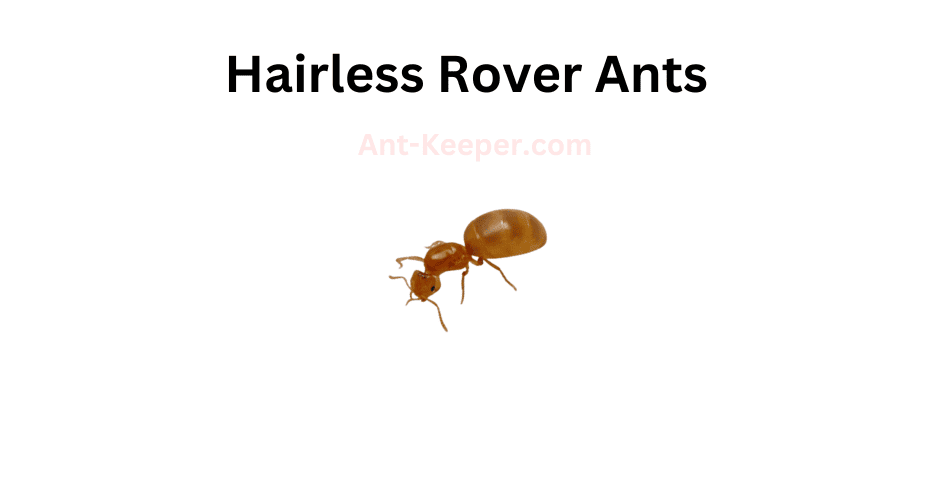
The Hairless Rover Ant, also known as Brachymyrmex patagonicus, is a small ant species that belongs to the family Formicidae.
These ants are typically found in urban and suburban areas, and are known for their hairless bodies and ability to quickly move from one location to another.
The Hairless Rover Ants are typically light brown in color and measure between 1.5 and 2.5 mm in length.
They have a distinct head and thorax, with a narrow waist and a bulbous abdomen.
Unlike other ant species, the Hairless Rover Ants lack the typical hairs that cover the body of most ants.
These ants are known for their ability to quickly move from one location to another, which is why they are often found in urban and suburban areas.
They are typically found in gardens, parks, and other areas where there is a lot of vegetation.
They are also known to invade homes and buildings, where they can be a nuisance to homeowners.
The Hairless Rover Ants are omnivorous, which means that they eat both plant and animal matter.
They are known to feed on insects, fruits, and other plant material.
They are also known to scavenge for food, and will often invade other ant colonies to steal their food.
The Hairless Rover Ants are social insects, and live in large colonies that can contain thousands of individuals.
They are known for their ability to quickly adapt to new environments, which is why they are able to thrive in urban and suburban areas.
Overall, the Hairless Rover Ants are an interesting and unique species of ant that are well adapted to living in urban and suburban environments.
While they can be a nuisance to homeowners, they play an important role in the ecosystem by helping to control insect populations and by serving as a food source for other animals.
28) Hercules Ants, Camponotus Herculeanus
The Hercules ant, also known as Dinoponera gigantea, is a species of ant that belongs to the family of Ponerinae.
These ants are known for their large size, with the workers measuring up to 3.5 cm in length, making them one of the largest ant species in the world.
Hercules ants are typically found in tropical rainforests, where they live in underground nests.
These nests can be quite extensive, with multiple chambers and tunnels that can extend several meters underground.
The ants are known for their aggressive behavior and will fiercely defend their nests against any intruders.
One of the most interesting features of the Hercules ant is their powerful mandibles.
These mandibles are so strong that they can easily crush the exoskeletons of other insects, making them formidable predators.
The ants are also known to hunt larger prey, such as spiders and scorpions.
Despite their aggressive behavior, Hercules ants are also known for their social behavior.
They live in colonies that can number in the hundreds, with a strict hierarchy that determines the roles of each individual ant.
The queen ant is responsible for laying eggs, while the workers are responsible for foraging, caring for the young, and defending the nest.
Overall, the Hercules ant is a fascinating species that has captured the attention of scientists and nature enthusiasts alike.
Their impressive size and strength make them a formidable predator, while their complex social behavior adds to their intrigue.
29) Carpenter And Sugar Ants, Camponotus Laevigatus

Carpenter ants and sugar ants are two common species of ants found in many regions of the world.
Carpenter ants are known for their ability to excavate wood and create nests within it.
They are typically larger in size than sugar ants and have a black or dark brown coloration.
Carpenter ants are also known for their strong mandibles, which they use to chew through wood and other materials.
Sugar ants, on the other hand, are smaller in size and have a yellow or brown coloration.
They are named for their preference for sugary foods and are often found in kitchens and other areas where food is stored.
Sugar ants are also known for their ability to form large colonies, with thousands of individual ants working together to gather food and care for their young.
Both carpenter ants and sugar ants play important roles in their ecosystems.
Carpenter ants help to break down dead wood and other plant material, which helps to recycle nutrients back into the soil.
Sugar ants help to disperse seeds and pollinate plants, which helps to maintain healthy ecosystems.
However, both species can also be pests when they invade human homes and buildings.
Carpenter ants can cause damage to wooden structures, while sugar ants can contaminate food and be a nuisance to homeowners.
It is important to take steps to prevent ant infestations and to control them if they do occur, in order to protect both human health and the health of the environment.
30) Carpenter And Sugar Ants, Camponotus Maccooki

Carpenter ants and sugar ants are two common species of ants found in many regions of the world.
Carpenter ants are known for their ability to excavate wood and create nests within it.
They are typically larger in size than sugar ants and have a black or dark brown coloration.
Carpenter ants are also known for their strong mandibles, which they use to chew through wood and other materials.
Sugar ants, on the other hand, are smaller in size and have a yellow or brown coloration.
They are named for their preference for sugary foods and are often found in kitchens and other areas where food is stored.
Sugar ants are also known for their ability to form large colonies, with thousands of individual ants working together to gather food and care for their young.
Both carpenter ants and sugar ants play important roles in their ecosystems.
Carpenter ants help to break down dead wood and other plant material, which helps to recycle nutrients back into the soil.
Sugar ants help to disperse seeds and pollinate plants, which helps to maintain healthy ecosystems.
However, both species can also be pests when they invade human homes and buildings.
Carpenter ants can cause damage to wooden structures, while sugar ants can contaminate food and be a nuisance to homeowners.
It is important to take steps to prevent ant infestations and to control them if they do occur, in order to protect both human health and the health of the environment.
31) Carpenter And Sugar Ants, Camponotus Modoc

Carpenter ants and sugar ants are two common species of ants found in many regions of the world.
Carpenter ants are known for their ability to excavate wood and create nests within it.
They are typically larger in size than sugar ants and have a black or dark brown coloration.
Carpenter ants are also known for their strong mandibles, which they use to chew through wood and other materials.
Sugar ants, on the other hand, are smaller in size and have a yellow or brown coloration.
They are named for their preference for sugary foods and are often found in kitchens and other areas where food is stored.
Sugar ants are also known for their ability to form large colonies, with thousands of individual ants working together to gather food and care for their young.
Both carpenter ants and sugar ants play important roles in their ecosystems.
Carpenter ants help to break down dead wood and other plant material, which helps to recycle nutrients back into the soil.
Sugar ants help to disperse seeds and pollinate plants, which helps to maintain healthy ecosystems.
However, both species can also be pests when they invade human homes and buildings.
Carpenter ants can cause damage to wooden structures, while sugar ants can contaminate food and be a nuisance to homeowners.
It is important to take steps to prevent ant infestations and to control them if they do occur, in order to protect both human health and the health of the environment.
32) Carpenter Ants, Camponotus Pennsylvanicus
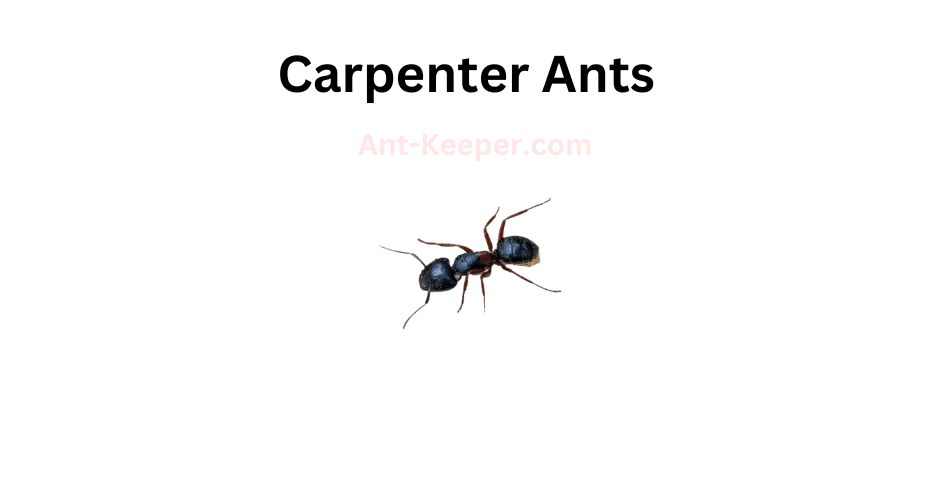
Carpenter ants are a species of ant that belong to the genus Camponotus.
They are known for their ability to excavate wood and create nests within it, which is why they are commonly referred to as "carpenter" ants.
These ants are typically black or red in color and can range in size from 6 to 12 millimeters in length.
Carpenter ants are social insects that live in colonies, which can range in size from a few hundred to several thousand individuals.
The colony is typically led by a queen ant, who is responsible for laying eggs and producing new members of the colony.
The workers, which make up the majority of the colony, are responsible for foraging for food, caring for the young, and maintaining the nest.
One of the most interesting aspects of carpenter ants is their ability to excavate wood.
Unlike termites, which eat wood, carpenter ants simply remove it to create their nests.
They do this by using their powerful mandibles to chew through the wood, creating tunnels and galleries that can extend several feet in length.
These tunnels are then used to house the colony and provide protection from predators and the elements.
Carpenter ants are also known for their role in the ecosystem.
They are important decomposers, breaking down dead wood and other organic matter and returning nutrients to the soil.
They also serve as a food source for other animals, including birds, reptiles, and mammals.
Despite their important ecological role, carpenter ants can also be a nuisance to humans.
They can cause damage to wooden structures, including homes and buildings, and can be difficult to control once they have established a nest.
However, with proper pest management techniques, it is possible to control carpenter ant populations and prevent damage to structures.
33) Black Carpenter Ants, Camponotus Pennsylvanicus
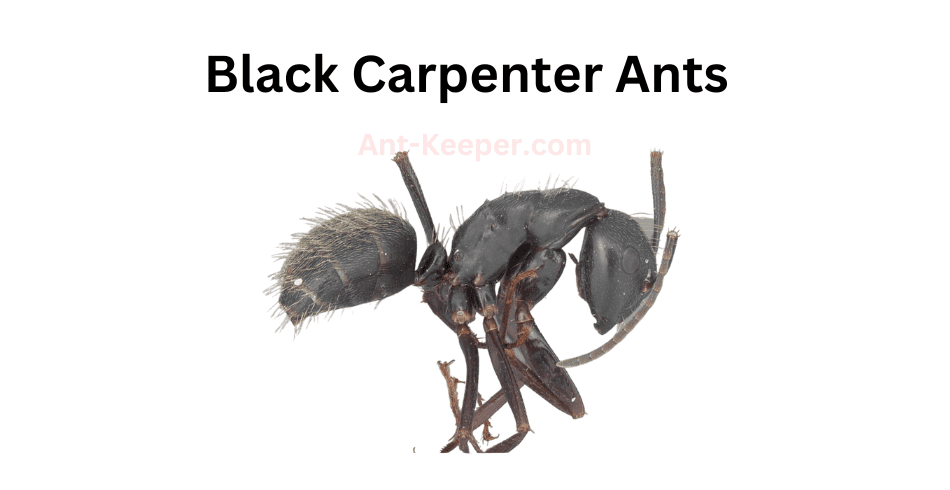
The Black Carpenter Ant (Camponotus pennsylvanicus) is a species of ant belonging to the family Formicidae.
These ants are commonly found in forests, woodlands, and urban areas across their range.
They are known for their large size, with workers measuring up to 1.5 cm in length.
Black Carpenter Ants are typically black in color, with some individuals having reddish-brown or yellowish hairs on their bodies.
They have a smooth and shiny exoskeleton, which helps to protect them from predators and environmental stressors.
These ants are known for their ability to excavate wood, which they use to create their nests.
They are often found in dead or decaying trees, but can also be found in wooden structures such as houses and buildings.
Black Carpenter Ants do not eat wood, but instead feed on a variety of insects, nectar, and honeydew.
The colony of Black Carpenter Ants is typically composed of a queen, workers, and soldiers.
The queen is responsible for laying eggs, while the workers are responsible for foraging, caring for the young, and maintaining the nest.
The soldiers are responsible for defending the colony against predators.
Black Carpenter Ants play an important role in their ecosystem, as they help to break down dead wood and recycle nutrients back into the soil.
However, they can also be considered a pest when they infest homes and buildings.
It is important to take preventative measures to avoid infestations, such as sealing cracks and crevices in the home and removing any decaying wood from the property.
34) Carpenter And Sugar Ants, Camponotus Vicinus

Carpenter ants and sugar ants are two common species of ants found in many regions of the world.
Carpenter ants are known for their ability to excavate wood and create nests within it.
They are typically larger in size than sugar ants and have a black or dark brown coloration.
Carpenter ants are also known for their strong mandibles, which they use to chew through wood and other materials.
Sugar ants, on the other hand, are smaller in size and have a yellow or brown coloration.
They are named for their preference for sugary foods and are often found in kitchens and other areas where food is stored.
Sugar ants are also known for their ability to form large colonies, with thousands of individual ants working together to gather food and care for their young.
Both carpenter ants and sugar ants play important roles in their ecosystems.
Carpenter ants help to break down dead wood and other plant material, which helps to recycle nutrients back into the soil.
Sugar ants help to disperse seeds and pollinate plants, which helps to maintain healthy ecosystems.
However, both species can also be pests when they invade human homes and buildings.
Carpenter ants can cause damage to wooden structures, while sugar ants can contaminate food and be a nuisance to homeowners.
It is important to take steps to prevent ant infestations and to control them if they do occur, in order to protect both human health and the health of the environment.
35) Wood Ants, Formica Accreta

Wood ants, also known as carpenter ants, are a species of ant that belong to the genus Camponotus.
They are widely distributed throughout the world and are commonly found in forests and woodlands.
These ants are known for their ability to excavate wood and create nests inside trees, logs, and other wooden structures.
Wood ants are typically large in size, with workers ranging from 6 to 13 millimeters in length.
They are usually black or brown in color and have a smooth, shiny exoskeleton.
These ants have strong mandibles that they use to chew through wood and defend their nests.
Wood ants are social insects that live in colonies consisting of a queen, workers, and soldiers.
The queen is responsible for laying eggs, while the workers and soldiers are responsible for maintaining the nest and protecting it from predators.
These ants communicate with each other using chemical signals called pheromones.
Wood ants are omnivores and feed on a variety of food sources, including insects, honeydew, and plant sap.
They are also known to scavenge for food and will sometimes raid the nests of other ant species.
Despite their ability to excavate wood, wood ants are not considered pests.
In fact, they play an important role in forest ecosystems by helping to decompose dead wood and recycle nutrients.
They also serve as a food source for many other animals, including birds, mammals, and other insects.
Overall, wood ants are fascinating creatures that have adapted to live in a unique habitat.
Their ability to excavate wood and create nests inside trees is a testament to their ingenuity and resourcefulness.
36) Wood Ants, Formica Altipetens

Wood ants, also known as carpenter ants, are a species of ant that belong to the genus Camponotus.
They are widely distributed throughout the world and are commonly found in forests and woodlands.
These ants are known for their ability to excavate wood and create nests inside trees, logs, and other wooden structures.
Wood ants are typically large in size, with workers ranging from 6 to 13 millimeters in length.
They are usually black or brown in color and have a smooth, shiny exoskeleton.
These ants have strong mandibles that they use to chew through wood and defend their nests.
Wood ants are social insects that live in colonies consisting of a queen, workers, and soldiers.
The queen is responsible for laying eggs, while the workers and soldiers are responsible for maintaining the nest and protecting it from predators.
These ants communicate with each other using chemical signals called pheromones.
Wood ants are omnivores and feed on a variety of food sources, including insects, honeydew, and plant sap.
They are also known to scavenge for food and will sometimes raid the nests of other ant species.
Despite their ability to excavate wood, wood ants are not considered pests.
In fact, they play an important role in forest ecosystems by helping to decompose dead wood and recycle nutrients.
They also serve as a food source for many other animals, including birds, mammals, and other insects.
Overall, wood ants are fascinating creatures that have adapted to live in a unique habitat.
Their ability to excavate wood and create nests inside trees is a testament to their ingenuity and resourcefulness.
37) Silver Ants, Formica Argentea
Silver ants, also known as Sahara ants or cataglyphis bombycina, are a species of desert ant that are found in arid regions around the world.
These ants are known for their unique ability to withstand extreme temperatures and navigate the harsh desert terrain.
Silver ants have a distinctive silver-grey coloration, which helps to reflect sunlight and keep their bodies cool in the scorching desert heat.
They are also equipped with long, slender legs that allow them to move quickly across the sand, and large compound eyes that help them navigate their surroundings.
One of the most remarkable features of silver ants is their ability to forage for food in the middle of the day, when temperatures can reach up to 70°C (158°F).
To do this, they have developed a unique heat tolerance mechanism that allows them to withstand temperatures that would be lethal to most other animals.
When the temperature rises, silver ants will seek out shade and reduce their activity levels to conserve energy.
They also have specialized hairs on their bodies that help to dissipate heat and prevent their internal organs from overheating.
Despite the harsh conditions of their environment, silver ants are highly social creatures that live in large colonies.
They communicate with each other using chemical signals and can work together to locate food sources and defend their territory.
Overall, silver ants are a fascinating species that have adapted to survive in one of the most inhospitable environments on Earth.
Their unique abilities and behaviors continue to intrigue scientists and researchers around the world.
38) Blood-Red Field Ants, Formica Aserva
The Blood-Red Field Ants, also known as Pheidole pallidula, are a species of ant that belong to the family Formicidae.
These ants are commonly found in grasslands and fields, where they build their nests in soil or under rocks.
The workers of this species are small, measuring around 2-3mm in length, and are reddish-brown in color.
They have large heads and mandibles, which they use to defend their colony and capture prey.
The queen ant is larger than the workers, measuring around 5mm in length, and is responsible for laying eggs.
Blood-Red Field Ants are omnivorous, feeding on a variety of food sources including insects, seeds, and nectar.
They are known to be aggressive towards other ant species and will defend their territory fiercely.
These ants have a unique defense mechanism where they release a chemical substance from their mandibular glands that acts as a repellent to potential predators.
This substance is also used to mark their territory and communicate with other members of their colony.
Blood-Red Field Ants play an important role in their ecosystem as they help to control the population of other insects and contribute to soil aeration.
They are also used in scientific research as a model organism to study social behavior and communication in ants.
Overall, the Blood-Red Field Ants are a fascinating species of ant that have adapted to thrive in grasslands and fields.
Their unique defense mechanism and social behavior make them an important species to study and understand.
39) Wood Ants, Formica Curiosa

Wood ants, also known as carpenter ants, are a species of ant that belong to the genus Camponotus.
They are widely distributed throughout the world and are commonly found in forests and woodlands.
These ants are known for their ability to excavate wood and create nests inside trees, logs, and other wooden structures.
Wood ants are typically large in size, with workers ranging from 6 to 13 millimeters in length.
They are usually black or brown in color and have a smooth, shiny exoskeleton.
These ants have strong mandibles that they use to chew through wood and defend their nests.
Wood ants are social insects that live in colonies consisting of a queen, workers, and soldiers.
The queen is responsible for laying eggs, while the workers and soldiers are responsible for maintaining the nest and protecting it from predators.
These ants communicate with each other using chemical signals called pheromones.
Wood ants are omnivores and feed on a variety of food sources, including insects, honeydew, and plant sap.
They are also known to scavenge for food and will sometimes raid the nests of other ant species.
Despite their ability to excavate wood, wood ants are not considered pests.
In fact, they play an important role in forest ecosystems by helping to decompose dead wood and recycle nutrients.
They also serve as a food source for many other animals, including birds, mammals, and other insects.
Overall, wood ants are fascinating creatures that have adapted to live in a unique habitat.
Their ability to excavate wood and create nests inside trees is a testament to their ingenuity and resourcefulness.
40) Wood Ants, Formica Densiventris

Wood ants, also known as carpenter ants, are a species of ant that belong to the genus Camponotus.
They are widely distributed throughout the world and are commonly found in forests and woodlands.
These ants are known for their ability to excavate wood and create nests inside trees, logs, and other wooden structures.
Wood ants are typically large in size, with workers ranging from 6 to 13 millimeters in length.
They are usually black or brown in color and have a smooth, shiny exoskeleton.
These ants have strong mandibles that they use to chew through wood and defend their nests.
Wood ants are social insects that live in colonies consisting of a queen, workers, and soldiers.
The queen is responsible for laying eggs, while the workers and soldiers are responsible for maintaining the nest and protecting it from predators.
These ants communicate with each other using chemical signals called pheromones.
Wood ants are omnivores and feed on a variety of food sources, including insects, honeydew, and plant sap.
They are also known to scavenge for food and will sometimes raid the nests of other ant species.
Despite their ability to excavate wood, wood ants are not considered pests.
In fact, they play an important role in forest ecosystems by helping to decompose dead wood and recycle nutrients.
They also serve as a food source for many other animals, including birds, mammals, and other insects.
Overall, wood ants are fascinating creatures that have adapted to live in a unique habitat.
Their ability to excavate wood and create nests inside trees is a testament to their ingenuity and resourcefulness.
41) Wood Ants, Formica Fuliginothorax

Wood ants, also known as carpenter ants, are a species of ant that belong to the genus Camponotus.
They are widely distributed throughout the world and are commonly found in forests and woodlands.
These ants are known for their ability to excavate wood and create nests inside trees, logs, and other wooden structures.
Wood ants are typically large in size, with workers ranging from 6 to 13 millimeters in length.
They are usually black or brown in color and have a smooth, shiny exoskeleton.
These ants have strong mandibles that they use to chew through wood and defend their nests.
Wood ants are social insects that live in colonies consisting of a queen, workers, and soldiers.
The queen is responsible for laying eggs, while the workers and soldiers are responsible for maintaining the nest and protecting it from predators.
These ants communicate with each other using chemical signals called pheromones.
Wood ants are omnivores and feed on a variety of food sources, including insects, honeydew, and plant sap.
They are also known to scavenge for food and will sometimes raid the nests of other ant species.
Despite their ability to excavate wood, wood ants are not considered pests.
In fact, they play an important role in forest ecosystems by helping to decompose dead wood and recycle nutrients.
They also serve as a food source for many other animals, including birds, mammals, and other insects.
Overall, wood ants are fascinating creatures that have adapted to live in a unique habitat.
Their ability to excavate wood and create nests inside trees is a testament to their ingenuity and resourcefulness.
42) Silky Ants, Formica Fusca
Silky ants, also known as velvet ants, are a type of solitary wasp that belong to the family Mutillidae.
They are found in various habitats such as forests, deserts, and grasslands.
These ants are known for their striking appearance, with their bright colors and dense, velvety hair covering their bodies.
Silky ants are typically between 0.5 to 1.5 inches in length and have a distinct, elongated body shape.
They have a tough exoskeleton that protects them from predators and environmental stressors.
Their bright colors, which can range from red to orange to black, serve as a warning to potential predators that they are venomous and should be avoided.
Despite their name, silky ants do not actually belong to the ant family.
They are wingless females that resemble ants in their appearance and behavior.
The males, on the other hand, have wings and are often mistaken for bees.
Silky ants are known for their painful sting, which is used to defend themselves from predators.
Their venom is potent and can cause intense pain, swelling, and even anaphylactic shock in some individuals.
However, they are not aggressive and will only sting if provoked or threatened.
Silky ants are important pollinators and play a crucial role in maintaining the ecological balance of their habitats.
They feed on nectar and pollen from flowers and help to transfer pollen from one plant to another, aiding in the reproduction of various plant species.
In conclusion, silky ants are fascinating creatures that are both beautiful and dangerous.
Their unique appearance and behavior make them a valuable addition to the natural world.
43) Wood Ants, Formica Hewitti

Wood ants, also known as carpenter ants, are a species of ant that belong to the genus Camponotus.
They are widely distributed throughout the world and are commonly found in forests and woodlands.
These ants are known for their ability to excavate wood and create nests inside trees, logs, and other wooden structures.
Wood ants are typically large in size, with workers ranging from 6 to 13 millimeters in length.
They are usually black or brown in color and have a smooth, shiny exoskeleton.
These ants have strong mandibles that they use to chew through wood and defend their nests.
Wood ants are social insects that live in colonies consisting of a queen, workers, and soldiers.
The queen is responsible for laying eggs, while the workers and soldiers are responsible for maintaining the nest and protecting it from predators.
These ants communicate with each other using chemical signals called pheromones.
Wood ants are omnivores and feed on a variety of food sources, including insects, honeydew, and plant sap.
They are also known to scavenge for food and will sometimes raid the nests of other ant species.
Despite their ability to excavate wood, wood ants are not considered pests.
In fact, they play an important role in forest ecosystems by helping to decompose dead wood and recycle nutrients.
They also serve as a food source for many other animals, including birds, mammals, and other insects.
Overall, wood ants are fascinating creatures that have adapted to live in a unique habitat.
Their ability to excavate wood and create nests inside trees is a testament to their ingenuity and resourcefulness.
44) Wood Ants, Formica Integra

Wood ants, also known as carpenter ants, are a species of ant that belong to the genus Camponotus.
They are widely distributed throughout the world and are commonly found in forests and woodlands.
These ants are known for their ability to excavate wood and create nests inside trees, logs, and other wooden structures.
Wood ants are typically large in size, with workers ranging from 6 to 13 millimeters in length.
They are usually black or brown in color and have a smooth, shiny exoskeleton.
These ants have strong mandibles that they use to chew through wood and defend their nests.
Wood ants are social insects that live in colonies consisting of a queen, workers, and soldiers.
The queen is responsible for laying eggs, while the workers and soldiers are responsible for maintaining the nest and protecting it from predators.
These ants communicate with each other using chemical signals called pheromones.
Wood ants are omnivores and feed on a variety of food sources, including insects, honeydew, and plant sap.
They are also known to scavenge for food and will sometimes raid the nests of other ant species.
Despite their ability to excavate wood, wood ants are not considered pests.
In fact, they play an important role in forest ecosystems by helping to decompose dead wood and recycle nutrients.
They also serve as a food source for many other animals, including birds, mammals, and other insects.
Overall, wood ants are fascinating creatures that have adapted to live in a unique habitat.
Their ability to excavate wood and create nests inside trees is a testament to their ingenuity and resourcefulness.
45) Fuzzy Mount Ants, Formica Lasioides
The Fuzzy Mount Ants, also known as Formica pilicornis, are a species of ant that belong to the Formicidae family.
These ants are commonly found in mountainous regions and are known for their distinctive fuzzy appearance.
The workers of this species are typically around 4-6mm in length and have a reddish-brown coloration with a dense covering of fine hairs, giving them their fuzzy appearance.
Fuzzy Mount Ants are social insects that live in colonies consisting of a queen, male ants, and worker ants.
The queen is responsible for laying eggs, while the male ants are responsible for mating with the queen.
The worker ants are responsible for foraging for food, caring for the young, and defending the colony.
These ants are omnivorous and feed on a variety of food sources, including insects, nectar, and honeydew.
They are also known to tend to aphids, which produce honeydew that the ants feed on.
Fuzzy Mount Ants are known for their aggressive behavior and will defend their colony fiercely against any perceived threats.
Fuzzy Mount Ants play an important role in their ecosystem as they help to control the population of other insects and contribute to the nutrient cycling process.
They are also an important food source for many other animals, including birds and mammals.
Overall, the Fuzzy Mount Ants are a fascinating species of ant that are known for their unique appearance and important role in their ecosystem.
46) Wood Ants, Formica Neogagates

Wood ants, also known as carpenter ants, are a species of ant that belong to the genus Camponotus.
They are widely distributed throughout the world and are commonly found in forests and woodlands.
These ants are known for their ability to excavate wood and create nests inside trees, logs, and other wooden structures.
Wood ants are typically large in size, with workers ranging from 6 to 13 millimeters in length.
They are usually black or brown in color and have a smooth, shiny exoskeleton.
These ants have strong mandibles that they use to chew through wood and defend their nests.
Wood ants are social insects that live in colonies consisting of a queen, workers, and soldiers.
The queen is responsible for laying eggs, while the workers and soldiers are responsible for maintaining the nest and protecting it from predators.
These ants communicate with each other using chemical signals called pheromones.
Wood ants are omnivores and feed on a variety of food sources, including insects, honeydew, and plant sap.
They are also known to scavenge for food and will sometimes raid the nests of other ant species.
Despite their ability to excavate wood, wood ants are not considered pests.
In fact, they play an important role in forest ecosystems by helping to decompose dead wood and recycle nutrients.
They also serve as a food source for many other animals, including birds, mammals, and other insects.
Overall, wood ants are fascinating creatures that have adapted to live in a unique habitat.
Their ability to excavate wood and create nests inside trees is a testament to their ingenuity and resourcefulness.
47) Red-Bearded Mound Ants, Formica Neorufibarbis
The Red-Bearded Mound Ants, scientifically known as Formica rufibarbis, are a species of ant that belong to the Formicidae family.
These ants are known for their distinctive red-colored beard-like hairs on their faces, which is where they get their common name from.
Red-Bearded Mound Ants are typically found in open areas such as meadows, fields, and forests.
They are known to build large mounds made of soil and plant material, which can reach up to 60 cm in height.
These mounds serve as their nests and can house thousands of ants.
These ants are social insects and live in colonies that are organized into a caste system.
The queen ant is responsible for laying eggs, while the worker ants are responsible for foraging for food, caring for the young, and defending the colony.
The males are only present during the mating season.
Red-Bearded Mound Ants are omnivorous and feed on a variety of food sources including insects, nectar, and honeydew.
They are also known to tend to aphids, which produce honeydew that the ants feed on.
These ants play an important role in their ecosystem as they help to control the population of other insects and serve as a food source for other animals such as birds and small mammals.
However, they can also be considered pests as they can damage crops and invade homes.
Overall, the Red-Bearded Mound Ants are a fascinating species of ant that are known for their unique appearance and important role in their ecosystem.
48) Western Thatching Ants, Formica Obscuripes
The Western Thatching Ant, also known as Formica obscuripes, is a species of ant that belongs to the Formicidae family.
These ants are commonly found in grasslands and forests throughout the western region of North America.
They are known for their unique ability to construct thatched nests made of grass and other plant materials.
The Western Thatching Ant is a medium-sized ant, with workers ranging in size from 4 to 8 millimeters in length.
They are typically dark brown or black in color, with a shiny exoskeleton.
These ants are highly social, living in large colonies that can contain up to several thousand individuals.
One of the most distinctive features of the Western Thatching Ant is their nest-building behavior.
These ants construct elaborate thatched nests made of grass and other plant materials.
The thatch serves as insulation, helping to regulate the temperature and humidity inside the nest.
The ants also use the thatch to protect the nest from predators and other environmental factors.
The Western Thatching Ant is an omnivorous species, feeding on a variety of foods including insects, nectar, and honeydew.
They are also known to tend to aphids, which produce honeydew that the ants feed on.
These ants are important members of their ecosystem, playing a role in seed dispersal and soil aeration.
Overall, the Western Thatching Ant is a fascinating species of ant that is well-adapted to its environment.
Their unique nest-building behavior and social structure make them an interesting subject for study and observation.
49) Northern Red Wood Ants, Formica Obscuriventris
The Northern Red Wood Ant, also known as Formica rufa, is a species of ant that belongs to the family Formicidae.
These ants are commonly found in forests and woodlands, where they build large nests made of twigs, leaves, and other organic materials.
The Northern Red Wood Ant is a relatively large ant, with workers measuring up to 10mm in length.
They are reddish-brown in color, with a darker head and thorax.
These ants are known for their aggressive behavior and will defend their nests fiercely against intruders.
These ants are omnivorous, feeding on a variety of insects, as well as honeydew produced by aphids and other insects.
They are also known to scavenge for food, and will even attack and kill other insects to feed their colony.
The Northern Red Wood Ant is an important species in forest ecosystems, as they help to aerate the soil and control populations of other insects.
They are also an important food source for many birds and other animals.
Overall, the Northern Red Wood Ant is a fascinating species of ant that plays an important role in forest ecosystems.
Their large nests and aggressive behavior make them a unique and interesting species to observe in the wild.
50) Wood Ants, Formica Pacifica

Wood ants, also known as carpenter ants, are a species of ant that belong to the genus Camponotus.
They are widely distributed throughout the world and are commonly found in forests and woodlands.
These ants are known for their ability to excavate wood and create nests inside trees, logs, and other wooden structures.
Wood ants are typically large in size, with workers ranging from 6 to 13 millimeters in length.
They are usually black or brown in color and have a smooth, shiny exoskeleton.
These ants have strong mandibles that they use to chew through wood and defend their nests.
Wood ants are social insects that live in colonies consisting of a queen, workers, and soldiers.
The queen is responsible for laying eggs, while the workers and soldiers are responsible for maintaining the nest and protecting it from predators.
These ants communicate with each other using chemical signals called pheromones.
Wood ants are omnivores and feed on a variety of food sources, including insects, honeydew, and plant sap.
They are also known to scavenge for food and will sometimes raid the nests of other ant species.
Despite their ability to excavate wood, wood ants are not considered pests.
In fact, they play an important role in forest ecosystems by helping to decompose dead wood and recycle nutrients.
They also serve as a food source for many other animals, including birds, mammals, and other insects.
Overall, wood ants are fascinating creatures that have adapted to live in a unique habitat.
Their ability to excavate wood and create nests inside trees is a testament to their ingenuity and resourcefulness.
51) Wood Ants, Formica Podzolica

Wood ants, also known as carpenter ants, are a species of ant that belong to the genus Camponotus.
They are widely distributed throughout the world and are commonly found in forests and woodlands.
These ants are known for their ability to excavate wood and create nests inside trees, logs, and other wooden structures.
Wood ants are typically large in size, with workers ranging from 6 to 13 millimeters in length.
They are usually black or brown in color and have a smooth, shiny exoskeleton.
These ants have strong mandibles that they use to chew through wood and defend their nests.
Wood ants are social insects that live in colonies consisting of a queen, workers, and soldiers.
The queen is responsible for laying eggs, while the workers and soldiers are responsible for maintaining the nest and protecting it from predators.
These ants communicate with each other using chemical signals called pheromones.
Wood ants are omnivores and feed on a variety of food sources, including insects, honeydew, and plant sap.
They are also known to scavenge for food and will sometimes raid the nests of other ant species.
Despite their ability to excavate wood, wood ants are not considered pests.
In fact, they play an important role in forest ecosystems by helping to decompose dead wood and recycle nutrients.
They also serve as a food source for many other animals, including birds, mammals, and other insects.
Overall, wood ants are fascinating creatures that have adapted to live in a unique habitat.
Their ability to excavate wood and create nests inside trees is a testament to their ingenuity and resourcefulness.
52) Wood Ants, Formica Ravida

Wood ants, also known as carpenter ants, are a species of ant that belong to the genus Camponotus.
They are widely distributed throughout the world and are commonly found in forests and woodlands.
These ants are known for their ability to excavate wood and create nests inside trees, logs, and other wooden structures.
Wood ants are typically large in size, with workers ranging from 6 to 13 millimeters in length.
They are usually black or brown in color and have a smooth, shiny exoskeleton.
These ants have strong mandibles that they use to chew through wood and defend their nests.
Wood ants are social insects that live in colonies consisting of a queen, workers, and soldiers.
The queen is responsible for laying eggs, while the workers and soldiers are responsible for maintaining the nest and protecting it from predators.
These ants communicate with each other using chemical signals called pheromones.
Wood ants are omnivores and feed on a variety of food sources, including insects, honeydew, and plant sap.
They are also known to scavenge for food and will sometimes raid the nests of other ant species.
Despite their ability to excavate wood, wood ants are not considered pests.
In fact, they play an important role in forest ecosystems by helping to decompose dead wood and recycle nutrients.
They also serve as a food source for many other animals, including birds, mammals, and other insects.
Overall, wood ants are fascinating creatures that have adapted to live in a unique habitat.
Their ability to excavate wood and create nests inside trees is a testament to their ingenuity and resourcefulness.
53) Wood Ants, Formica Transmontanis

Wood ants, also known as carpenter ants, are a species of ant that belong to the genus Camponotus.
They are widely distributed throughout the world and are commonly found in forests and woodlands.
These ants are known for their ability to excavate wood and create nests inside trees, logs, and other wooden structures.
Wood ants are typically large in size, with workers ranging from 6 to 13 millimeters in length.
They are usually black or brown in color and have a smooth, shiny exoskeleton.
These ants have strong mandibles that they use to chew through wood and defend their nests.
Wood ants are social insects that live in colonies consisting of a queen, workers, and soldiers.
The queen is responsible for laying eggs, while the workers and soldiers are responsible for maintaining the nest and protecting it from predators.
These ants communicate with each other using chemical signals called pheromones.
Wood ants are omnivores and feed on a variety of food sources, including insects, honeydew, and plant sap.
They are also known to scavenge for food and will sometimes raid the nests of other ant species.
Despite their ability to excavate wood, wood ants are not considered pests.
In fact, they play an important role in forest ecosystems by helping to decompose dead wood and recycle nutrients.
They also serve as a food source for many other animals, including birds, mammals, and other insects.
Overall, wood ants are fascinating creatures that have adapted to live in a unique habitat.
Their ability to excavate wood and create nests inside trees is a testament to their ingenuity and resourcefulness.
54) Formicoxenus Diversipilosus
Formicoxenus diversipilosus is a species of ant belonging to the subfamily Myrmicinae.
These ants are small in size, measuring around 2-3 mm in length.
They are characterized by their unique pilosity, with a combination of long and short hairs covering their body.
The head and thorax of Formicoxenus diversipilosus are reddish-brown in color, while the abdomen is darker.
Formicoxenus diversipilosus is known to inhabit forested areas, where they nest in dead wood or under bark.
They are also known to form satellite colonies, which are smaller colonies that are connected to the main colony by trails.
These ants are omnivorous, feeding on a variety of food sources including insects, nectar, and honeydew.
One interesting aspect of Formicoxenus diversipilosus is their social structure.
They are known to have a polygynous queen system, where multiple queens coexist within a colony.
This is a rare trait among ants, as most species have a single queen per colony.
The presence of multiple queens in Formicoxenus diversipilosus colonies is thought to increase the reproductive success of the colony.
Overall, Formicoxenus diversipilosus is a fascinating species of ant with unique physical and behavioral characteristics.
Their small size and inconspicuous nature make them easy to overlook, but they play an important role in forest ecosystems as predators and scavengers.
55) Cornfield Ants, Lasius Alienus
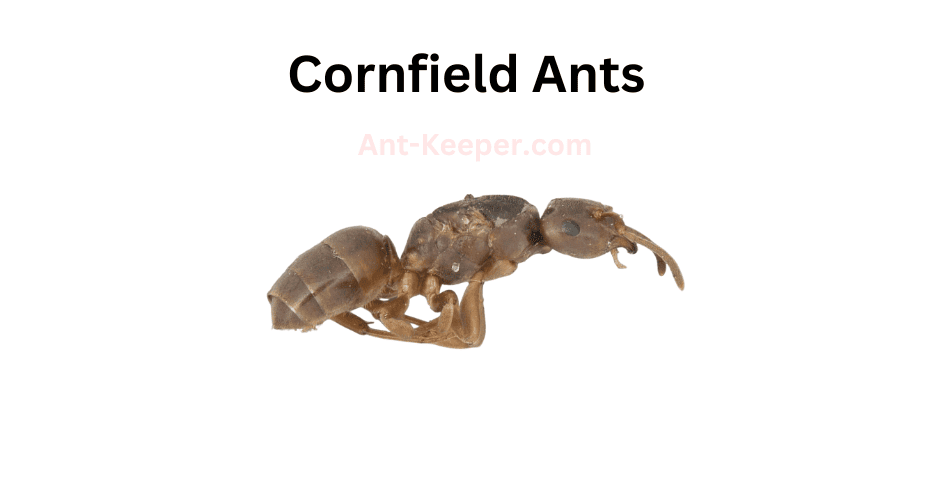
Cornfield ants, also known as Lasius neoniger, are a species of ant that belong to the Formicidae family.
These ants are commonly found in agricultural fields and grasslands, where they build their nests in the soil.
They are known for their ability to form large colonies, with thousands of individuals living together in a single nest.
Cornfield ants are small in size, measuring between 2.5 and 4 mm in length.
They are typically black or dark brown in color, with a shiny and smooth exoskeleton.
These ants are omnivorous, feeding on a variety of food sources including insects, seeds, and honeydew produced by aphids.
One of the most interesting aspects of cornfield ants is their ability to form symbiotic relationships with other insects.
They are known to protect and care for aphids, which in turn produce honeydew that the ants feed on.
This relationship benefits both the ants and the aphids, as the ants receive a reliable food source while the aphids are protected from predators.
Cornfield ants are also important for their role in soil health.
Their nests help to aerate the soil and improve its structure, which can benefit plant growth.
Additionally, their foraging activities help to distribute nutrients throughout the soil.
Overall, cornfield ants are an important species in agricultural ecosystems.
Their ability to form large colonies and symbiotic relationships with other insects make them a fascinating subject for study.
56) Wide-Legged Citronella Ants, Lasius Latipes
The Wide-Legged Citronella Ants, also known as Acanthomyrmex ferox, are a species of ants that belong to the Formicidae family.
These ants are known for their distinct appearance, with their long and slender legs that are wider than their body.
They are typically reddish-brown in color and have a strong citronella odor.
The Wide-Legged Citronella Ants are found in tropical and subtropical regions, where they inhabit forests and grasslands.
They are known to be aggressive and territorial, often engaging in battles with other ant species for resources and territory.
These ants are omnivorous, feeding on a variety of food sources including insects, nectar, and plant sap.
They are also known to cultivate fungi in their nests, which they use as a food source.
The Wide-Legged Citronella Ants are social insects, living in colonies that can range from a few hundred to several thousand individuals.
They have a complex social structure, with different castes of ants performing specific roles within the colony.
The queen ant is responsible for laying eggs, while the worker ants are responsible for foraging, caring for the young, and defending the colony.
Overall, the Wide-Legged Citronella Ants are an important part of the ecosystem, playing a role in seed dispersal, soil aeration, and nutrient cycling.
However, their aggressive behavior and territorial nature can sometimes make them a nuisance to humans.
57) New World Fuzz Ants, Lasius Nearcticus
The New World Fuzz Ants are a species of ants that belong to the family Formicidae.
They are known for their distinctive appearance, which includes a dense covering of fine hairs or fuzz on their bodies.
This fuzz serves as a form of insulation, helping the ants to regulate their body temperature and stay cool in hot environments.
New World Fuzz Ants are typically found in tropical and subtropical regions, where they live in colonies that can number in the thousands.
They are omnivorous, feeding on a variety of plant and animal matter, including insects, fruit, and nectar.
They are also known to engage in mutualistic relationships with other insects, such as aphids, which they protect in exchange for a sugary secretion known as honeydew.
One of the most interesting aspects of New World Fuzz Ants is their social behavior.
They are highly organized and work together to build and maintain their nests, which can be located both above and below ground.
They also have a complex system of communication, using chemical signals known as pheromones to coordinate their activities and alert each other to potential threats.
Despite their small size, New World Fuzz Ants play an important role in their ecosystems.
They help to control insect populations, pollinate plants, and contribute to nutrient cycling in the soil.
They are also a valuable source of food for many other animals, including birds, reptiles, and mammals.
Overall, the New World Fuzz Ants are a fascinating and important species that demonstrate the complexity and diversity of life on our planet.
58) Labour Day Ants, Lasius Neoniger
The Labour Day Ants, also known as the May Day Ants, are a species of ants that are commonly found in temperate regions around the world.
These ants are known for their hardworking nature and their ability to work together as a team to achieve their goals.
The Labour Day Ants are social insects that live in large colonies, which can consist of thousands of individuals.
The colony is usually led by a queen ant, who is responsible for laying eggs and producing new members of the colony.
The other ants in the colony are divided into different castes, including workers, soldiers, and reproductive ants.
The workers are the most numerous members of the colony and are responsible for gathering food, caring for the young, and maintaining the nest.
These ants are known for their tireless work ethic and their ability to work together to accomplish tasks.
They are also known for their ability to carry objects that are many times their own body weight.
The soldiers are responsible for defending the colony from predators and other threats.
These ants have larger heads and mandibles than the workers and are capable of delivering a painful bite to any intruders.
The reproductive ants are responsible for mating and producing new members of the colony.
These ants have wings and are capable of flying to new locations to start new colonies.
Overall, the Labour Day Ants are a fascinating species of ants that are known for their hardworking nature and their ability to work together as a team.
They are an important part of many ecosystems and play a vital role in maintaining the balance of nature.
59) Black Garden Ants, Lasius Niger
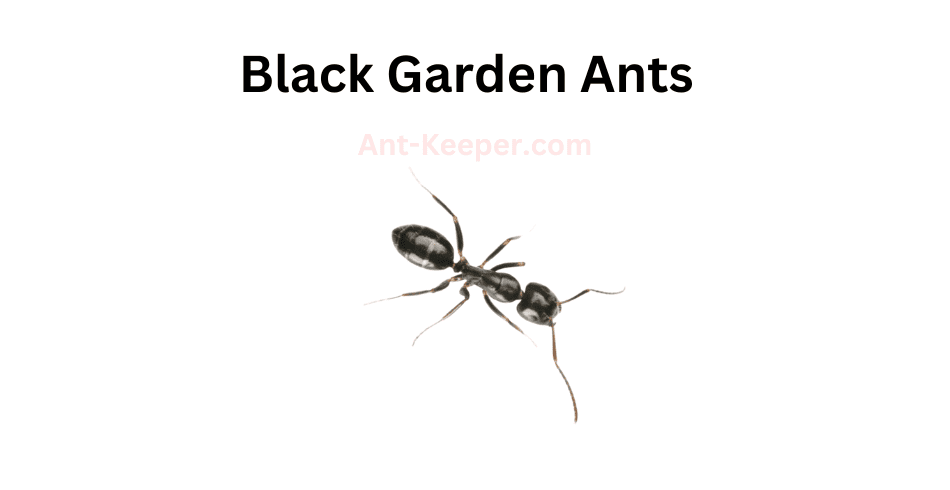
The Black Garden Ant, also known as Lasius niger, is a common species of ant found in many parts of the world.
These ants are typically black or dark brown in color and range in size from 2.5 to 4 mm in length.
Black Garden Ants are social insects that live in large colonies, which can contain thousands of individuals.
The colony is typically led by a queen ant, who is responsible for laying eggs and producing new workers.
The workers are responsible for foraging for food, caring for the young, and defending the colony from predators.
These ants are omnivorous and will eat a variety of foods, including insects, nectar, and honeydew.
They are also known to farm aphids, which they protect and feed in exchange for the sweet honeydew they produce.
Black Garden Ants are important members of their ecosystem, as they help to aerate soil and control populations of other insects.
However, they can also be considered pests when they invade homes and gardens in search of food and shelter.
Overall, the Black Garden Ant is a fascinating and important species of ant that plays a vital role in many ecosystems around the world.
60) Moisture Ants, Lasius Occidentalis

Moisture ants are a type of ant that is commonly found in damp environments.
They are known for their ability to thrive in areas with high levels of moisture, such as in rotting wood or in soil that is constantly moist.
These ants are typically small in size, measuring only a few millimeters in length, and are usually yellow or brown in color.
Moisture ants are social insects that live in colonies, with each colony consisting of a queen, workers, and soldiers.
The queen is responsible for laying eggs, while the workers and soldiers are responsible for maintaining the colony and protecting it from predators.
One of the unique characteristics of moisture ants is their ability to create satellite colonies.
These colonies are established in nearby locations and are connected to the main colony by a network of tunnels.
This allows the ants to expand their territory and increase their chances of survival.
Moisture ants are also known for their ability to control the moisture levels in their environment.
They do this by building intricate nests that are designed to regulate the humidity levels inside.
This is important for the survival of the colony, as too much moisture can lead to the growth of harmful fungi and bacteria.
Overall, moisture ants are fascinating creatures that have adapted to thrive in environments that would be inhospitable to many other species.
Their ability to control moisture levels and create satellite colonies makes them a formidable force in their ecosystem.
61) Moisture Ants, Lasius Pallitarsis

Moisture ants are a type of ant that is commonly found in damp environments.
They are known for their ability to thrive in areas with high levels of moisture, such as in rotting wood or in soil that is constantly moist.
These ants are typically small in size, measuring only a few millimeters in length, and are usually yellow or brown in color.
Moisture ants are social insects that live in colonies, with each colony consisting of a queen, workers, and soldiers.
The queen is responsible for laying eggs, while the workers and soldiers are responsible for maintaining the colony and protecting it from predators.
One of the unique characteristics of moisture ants is their ability to create satellite colonies.
These colonies are established in nearby locations and are connected to the main colony by a network of tunnels.
This allows the ants to expand their territory and increase their chances of survival.
Moisture ants are also known for their ability to control the moisture levels in their environment.
They do this by building intricate nests that are designed to regulate the humidity levels inside.
This is important for the survival of the colony, as too much moisture can lead to the growth of harmful fungi and bacteria.
Overall, moisture ants are fascinating creatures that have adapted to thrive in environments that would be inhospitable to many other species.
Their ability to control moisture levels and create satellite colonies makes them a formidable force in their ecosystem.
62) Moisture Ants, Lasius Subumbratus

Moisture ants are a type of ant that is commonly found in damp environments.
They are known for their ability to thrive in areas with high levels of moisture, such as in rotting wood or in soil that is constantly moist.
These ants are typically small in size, measuring only a few millimeters in length, and are usually yellow or brown in color.
Moisture ants are social insects that live in colonies, with each colony consisting of a queen, workers, and soldiers.
The queen is responsible for laying eggs, while the workers and soldiers are responsible for maintaining the colony and protecting it from predators.
One of the unique characteristics of moisture ants is their ability to create satellite colonies.
These colonies are established in nearby locations and are connected to the main colony by a network of tunnels.
This allows the ants to expand their territory and increase their chances of survival.
Moisture ants are also known for their ability to control the moisture levels in their environment.
They do this by building intricate nests that are designed to regulate the humidity levels inside.
This is important for the survival of the colony, as too much moisture can lead to the growth of harmful fungi and bacteria.
Overall, moisture ants are fascinating creatures that have adapted to thrive in environments that would be inhospitable to many other species.
Their ability to control moisture levels and create satellite colonies makes them a formidable force in their ecosystem.
63) Yellow Shadow Ants, Lasius Umbratus
Yellow Shadow Ants, also known as Oecophylla smaragdina, are a species of arboreal ant found in tropical regions around the world.
These ants are known for their distinctive yellow coloration and their ability to form large colonies in trees.
Yellow Shadow Ants are highly social insects, with colonies consisting of thousands of individuals.
They are known for their aggressive behavior and their ability to defend their territory from other ant species and predators.
These ants are also known for their unique nesting behavior, which involves weaving together leaves and other plant materials to create a nest in the canopy of trees.
One of the most interesting aspects of Yellow Shadow Ant behavior is their use of larvae as a form of defense.
When threatened, worker ants will carry larvae to the edge of the nest and use them to attack intruders.
The larvae have a sticky secretion that can immobilize predators, allowing the worker ants to attack and drive them away.
Yellow Shadow Ants are also important for their role in ecosystem functioning.
They are known to be effective predators of other insects, and their presence can help to control pest populations in agricultural areas.
Additionally, their nesting behavior can help to improve soil quality and nutrient cycling in forest ecosystems.
Overall, Yellow Shadow Ants are a fascinating and important species of ant that play an important role in tropical ecosystems around the world.
64) Mossy Thin Ants, Leptothorax Muscorum
Mossy Thin Ants, also known as Leptogenys attenuata, are a species of ants that belong to the subfamily Ponerinae.
These ants are typically found in forested areas and are known for their slender and elongated bodies, which are covered in a moss-like texture.
Mossy Thin Ants are typically black or dark brown in color and have long, thin legs that allow them to move quickly and efficiently through their environment.
They are also known for their large mandibles, which they use to capture and subdue their prey.
These ants are primarily carnivorous and feed on a variety of insects and other small invertebrates.
They are also known to scavenge for food and will consume dead animals and other organic matter.
Mossy Thin Ants are social insects and live in colonies that can range in size from a few dozen to several hundred individuals.
The colonies are typically led by a queen ant, who is responsible for laying eggs and maintaining the overall health of the colony.
Despite their small size, Mossy Thin Ants play an important role in their ecosystem.
They help to control the populations of other insects and contribute to the overall health of the forest ecosystem.
65) Leptothorax Muscorum Uvicensis
Leptothorax muscorum uvicensis is a species of ant that belongs to the family Formicidae.
These ants are commonly found in forested areas and are known for their small size, measuring only 2-3mm in length.
They have a dark brown or black coloration and are often mistaken for other ant species due to their similar appearance.
Leptothorax muscorum uvicensis ants are social insects that live in colonies consisting of hundreds of individuals.
They are known for their cooperative behavior and division of labor, with each ant having a specific role within the colony.
These ants are also known for their ability to communicate with each other through the use of chemical signals, which they use to coordinate their activities and defend their territory.
One interesting aspect of Leptothorax muscorum uvicensis ants is their ability to adapt to their environment.
They are able to survive in a variety of habitats, including forests, meadows, and even urban areas.
They are also able to adjust their behavior in response to changes in their environment, such as changes in temperature or food availability.
Overall, Leptothorax muscorum uvicensis ants are fascinating creatures that play an important role in their ecosystem.
Their social behavior and adaptability make them a valuable subject of study for scientists and researchers.
66) Velvety Tree Ants, Liometopum Luctuosum

Velvety Tree Ants, also known as Liometopum occidentale, are a species of ant that belong to the family Formicidae.
These ants are commonly found in forested areas and are known for their unique appearance and behavior.
Velvety Tree Ants are typically black or dark brown in color and have a velvety texture to their bodies.
They are relatively large ants, with workers measuring up to 10mm in length.
These ants are also known for their distinctive mandibles, which are used for cutting and carrying food.
One of the most interesting aspects of Velvety Tree Ants is their nesting behavior.
These ants build large nests in trees, which can be up to several meters in diameter.
The nests are made from a combination of plant material and the ants' own saliva, which creates a strong and durable structure.
Velvety Tree Ants are omnivorous, meaning that they eat both plant and animal matter.
They are known to feed on a variety of insects, as well as honeydew produced by aphids and other insects.
These ants are also known to cultivate fungi within their nests, which they use as a food source.
In terms of their ecological role, Velvety Tree Ants are important predators and scavengers in forest ecosystems.
They help to control populations of other insects and contribute to nutrient cycling by breaking down organic matter.
Overall, Velvety Tree Ants are a fascinating and important species of ant that play an important role in forest ecosystems.
Their unique appearance and behavior make them a popular subject of study for scientists and nature enthusiasts alike.
67) Manica Hunteri
Manica Hunteribe is a species of ant that belongs to the family Formicidae.
These ants are known for their aggressive hunting behavior and are often found in forested areas.
The workers of this species are small in size, measuring around 4-5 mm in length, and are typically reddish-brown in color.
Manica Hunteribe ants are known to be highly territorial and will aggressively defend their nests against intruders.
They are also skilled hunters and will actively search for prey, which typically includes other insects and small arthropods.
These ants are known to use a variety of hunting techniques, including group hunting and ambush tactics.
One interesting aspect of Manica Hunteribe ants is their ability to communicate with each other through chemical signals.
They use pheromones to mark trails and communicate with other members of their colony.
This allows them to coordinate their hunting efforts and defend their territory more effectively.
Overall, Manica Hunteribe ants are fascinating creatures that play an important role in their ecosystem.
Their aggressive hunting behavior and territorial nature make them a formidable force in the forest, and their ability to communicate with each other through chemical signals is a testament to their intelligence and adaptability.
68) Manica Invidia
Manica Invidiabe is a species of ant that belongs to the family Formicidae.
These ants are known for their aggressive behavior and are often found in large colonies.
The workers of this species are typically around 5-6 mm in length and are reddish-brown in color.
One of the most interesting features of Manica Invidiabe is their ability to communicate with each other through chemical signals.
They use pheromones to mark trails and to signal danger or the presence of food.
This allows them to work together efficiently and effectively.
Manica Invidiabe is also known for their predatory behavior.
They are skilled hunters and will often prey on other insects and small animals.
They have strong mandibles that allow them to capture and kill their prey quickly.
Despite their aggressive behavior, Manica Invidiabe plays an important role in their ecosystem.
They help to control the population of other insects and contribute to the overall health of their environment.
Overall, Manica Invidiabe is a fascinating species of ant that has many unique characteristics.
Their ability to communicate through chemical signals and their predatory behavior make them an important part of their ecosystem.
69) Furrowed Ants, Myrmica Alaskensis

Furrowed ants, also known as Pheidole ruginoda, are a species of ant that belong to the family Formicidae.
These ants are commonly found in various habitats such as forests, grasslands, and deserts.
They are known for their distinctive appearance, with a furrowed head and thorax, and a smooth and shiny abdomen.
Furrowed ants are social insects that live in colonies, which can range in size from a few hundred to several thousand individuals.
The colony is typically headed by a queen ant, whose primary role is to lay eggs.
The workers, which are sterile females, are responsible for foraging, nest maintenance, and caring for the young.
These ants are omnivorous, meaning they feed on both plant and animal matter.
Their diet consists of seeds, insects, and other small invertebrates.
They are also known to tend to aphids, which produce a sugary substance that the ants feed on.
Furrowed ants are known for their aggressive behavior, and will defend their colony fiercely against intruders.
They have been observed engaging in territorial battles with other ant species, and will even attack larger insects such as grasshoppers and beetles.
Overall, furrowed ants are an important part of many ecosystems, playing a crucial role in seed dispersal and soil aeration.
Their unique appearance and behavior make them a fascinating subject for study and observation.
70) Furrowed Ants, Myrmica Detritinodis

Furrowed ants, also known as Pheidole ruginoda, are a species of ant that belong to the family Formicidae.
These ants are commonly found in various habitats such as forests, grasslands, and deserts.
They are known for their distinctive appearance, with a furrowed head and thorax, and a smooth and shiny abdomen.
Furrowed ants are social insects that live in colonies, which can range in size from a few hundred to several thousand individuals.
The colony is typically headed by a queen ant, whose primary role is to lay eggs.
The workers, which are sterile females, are responsible for foraging, nest maintenance, and caring for the young.
These ants are omnivorous, meaning they feed on both plant and animal matter.
Their diet consists of seeds, insects, and other small invertebrates.
They are also known to tend to aphids, which produce a sugary substance that the ants feed on.
Furrowed ants are known for their aggressive behavior, and will defend their colony fiercely against intruders.
They have been observed engaging in territorial battles with other ant species, and will even attack larger insects such as grasshoppers and beetles.
Overall, furrowed ants are an important part of many ecosystems, playing a crucial role in seed dispersal and soil aeration.
Their unique appearance and behavior make them a fascinating subject for study and observation.
71) Furrowed Ants, Myrmica Discontinua

Furrowed ants, also known as Pheidole ruginoda, are a species of ant that belong to the family Formicidae.
These ants are commonly found in various habitats such as forests, grasslands, and deserts.
They are known for their distinctive appearance, with a furrowed head and thorax, and a smooth and shiny abdomen.
Furrowed ants are social insects that live in colonies, which can range in size from a few hundred to several thousand individuals.
The colony is typically headed by a queen ant, whose primary role is to lay eggs.
The workers, which are sterile females, are responsible for foraging, nest maintenance, and caring for the young.
These ants are omnivorous, meaning they feed on both plant and animal matter.
Their diet consists of seeds, insects, and other small invertebrates.
They are also known to tend to aphids, which produce a sugary substance that the ants feed on.
Furrowed ants are known for their aggressive behavior, and will defend their colony fiercely against intruders.
They have been observed engaging in territorial battles with other ant species, and will even attack larger insects such as grasshoppers and beetles.
Overall, furrowed ants are an important part of many ecosystems, playing a crucial role in seed dispersal and soil aeration.
Their unique appearance and behavior make them a fascinating subject for study and observation.
72) Incomplete Fire Ants, Myrmica Incompleta
The Incomplete Fire Ant is a species of ant that belongs to the genus Solenopsis.
These ants are known for their aggressive behavior and painful sting, which can cause severe allergic reactions in some individuals.
The Incomplete Fire Ant gets its name from the fact that it lacks a complete thorax, which is the middle section of the ant's body.
This unique physical characteristic sets it apart from other species of ants.
The Incomplete Fire Ant is typically reddish-brown in color and ranges in size from 2 to 6 millimeters in length.
They are social insects and live in large colonies that can contain thousands of individuals.
The colony is usually led by a queen ant, who is responsible for laying eggs and maintaining the colony's population.
These ants are omnivorous and feed on a variety of foods, including insects, seeds, and nectar.
They are also known to scavenge for food and will often invade other ant colonies to steal their resources.
The Incomplete Fire Ant is considered a pest in many areas due to its aggressive behavior and painful sting.
They can cause damage to crops and gardens and can also pose a threat to humans and animals.
In some cases, their sting can be life-threatening, especially for individuals who are allergic to their venom.
Overall, the Incomplete Fire Ant is a fascinating species of ant that has unique physical characteristics and behaviors.
While they can be a nuisance and a danger to humans and animals, they play an important role in the ecosystem and are an important part of the food chain.
73) Furrowed Ants, Myrmica Rubra

Furrowed ants, also known as Pheidole ruginoda, are a species of ant that belong to the family Formicidae.
These ants are commonly found in various habitats such as forests, grasslands, and deserts.
They are known for their distinctive appearance, with a furrowed head and thorax, and a smooth and shiny abdomen.
Furrowed ants are social insects that live in colonies, which can range in size from a few hundred to several thousand individuals.
The colony is typically headed by a queen ant, whose primary role is to lay eggs.
The workers, which are sterile females, are responsible for foraging, nest maintenance, and caring for the young.
These ants are omnivorous, meaning they feed on both plant and animal matter.
Their diet consists of seeds, insects, and other small invertebrates.
They are also known to tend to aphids, which produce a sugary substance that the ants feed on.
Furrowed ants are known for their aggressive behavior, and will defend their colony fiercely against intruders.
They have been observed engaging in territorial battles with other ant species, and will even attack larger insects such as grasshoppers and beetles.
Overall, furrowed ants are an important part of many ecosystems, playing a crucial role in seed dispersal and soil aeration.
Their unique appearance and behavior make them a fascinating subject for study and observation.
74) Furrowed Ants, Myrmica Tahoensis

Furrowed ants, also known as Pheidole ruginoda, are a species of ant that belong to the family Formicidae.
These ants are commonly found in various habitats such as forests, grasslands, and deserts.
They are known for their distinctive appearance, with a furrowed head and thorax, and a smooth and shiny abdomen.
Furrowed ants are social insects that live in colonies, which can range in size from a few hundred to several thousand individuals.
The colony is typically headed by a queen ant, whose primary role is to lay eggs.
The workers, which are sterile females, are responsible for foraging, nest maintenance, and caring for the young.
These ants are omnivorous, meaning they feed on both plant and animal matter.
Their diet consists of seeds, insects, and other small invertebrates.
They are also known to tend to aphids, which produce a sugary substance that the ants feed on.
Furrowed ants are known for their aggressive behavior, and will defend their colony fiercely against intruders.
They have been observed engaging in territorial battles with other ant species, and will even attack larger insects such as grasshoppers and beetles.
Overall, furrowed ants are an important part of many ecosystems, playing a crucial role in seed dispersal and soil aeration.
Their unique appearance and behavior make them a fascinating subject for study and observation.
75) Big Headed Ants, Pheidole Californica

Big Headed Ants, also known as Pheidole megacephala, are a species of ant that belong to the family Formicidae.
These ants are known for their distinctive large heads, which are used for defense and communication within their colonies.
Big Headed Ants are typically found in tropical and subtropical regions, where they build their nests in soil, leaf litter, and other organic matter.
They are omnivorous, feeding on a variety of insects, seeds, and other small organisms.
One of the most interesting aspects of Big Headed Ants is their social behavior.
They live in large colonies, with a queen ant at the center of the hierarchy.
The queen is responsible for laying eggs, while the other ants in the colony perform various tasks such as foraging for food, caring for the young, and defending the colony from predators.
Big Headed Ants are also known for their ability to displace other ant species in their habitats.
They are aggressive and have been known to attack and kill other ants, as well as compete with them for resources.
Despite their aggressive behavior, Big Headed Ants are not considered a major pest species.
However, their ability to displace other ant species and their potential impact on native ecosystems make them an important species to study and monitor.
76) Typical American Harvester Ants, Pogonomyrmex Occidentalis

The typical American Harvester Ant (Pogonomyrmex spp.) is a species of ant that belongs to the family Formicidae.
These ants are commonly found in grasslands and deserts throughout North America.
They are known for their impressive ability to harvest and store seeds, which they use as a primary food source.
The American Harvester Ant is a medium-sized ant, with workers ranging in size from 4 to 8 mm in length.
They have a distinctive reddish-brown coloration and a large head with powerful mandibles.
These ants are highly social and live in large colonies, with a single queen responsible for laying eggs and producing new workers.
One of the most notable characteristics of the American Harvester Ant is their impressive seed harvesting behavior.
These ants use their powerful mandibles to cut and collect seeds from nearby plants, which they then carry back to their nest.
Once inside the nest, the ants store the seeds in underground chambers, where they can be accessed as needed.
In addition to their seed harvesting behavior, American Harvester Ants are also known for their aggressive defense of their nests.
These ants will fiercely defend their colony against any perceived threat, using their powerful mandibles to bite and sting intruders.
Overall, the American Harvester Ant is a fascinating species of ant with unique behaviors and adaptations that allow them to thrive in their native habitats.
Their impressive seed harvesting abilities and aggressive defense strategies make them an important part of many North American ecosystems.
77) Western Amazon Ants, Polyergus Mexicanus
The Western Amazon Ants, also known as the Atta cephalotes, are a species of leaf-cutter ants found in the tropical rainforests of South America.
These ants are known for their impressive ability to cut and transport large pieces of leaves, which they use to cultivate a fungus that serves as their primary food source.
The Western Amazon Ants are social insects that live in large colonies, with each colony consisting of millions of individuals.
The colony is organized into different castes, with the queen being the largest and most important member.
The queen is responsible for laying eggs, which hatch into larvae that are cared for by the worker ants.
The worker ants are the ones responsible for cutting and transporting the leaves, as well as tending to the fungus gardens.
They are also responsible for defending the colony against predators and other threats.
The soldiers, which are larger and more heavily armored than the workers, are responsible for protecting the colony from larger predators.
The Western Amazon Ants are important members of the rainforest ecosystem, as they help to break down and recycle organic matter.
They also serve as a food source for many other animals, including birds, reptiles, and mammals.
Despite their importance, the Western Amazon Ants are facing threats from habitat destruction and climate change.
As their habitat is destroyed, their populations are declining, which could have serious consequences for the rainforest ecosystem as a whole.
Conservation efforts are underway to protect these important insects and their habitat.
78) Diecks Slender Ants, Stenamma Diecki
Dieck's Slender Ants, also known as Leptomyrmex diecki, are a species of ant that belong to the subfamily Dolichoderinae.
These ants are known for their slender and elongated bodies, which are typically black or dark brown in color.
They are relatively small in size, with workers measuring between 3-5mm in length.
Dieck's Slender Ants are typically found in forested areas, where they build their nests in soil or leaf litter.
They are known to be highly territorial and aggressive towards other ant species, often engaging in fierce battles to defend their territory.
One of the most interesting aspects of Dieck's Slender Ants is their unique method of communication.
These ants use a combination of chemical signals and physical cues to communicate with one another, including tapping their antennae and legs to convey messages.
In terms of diet, Dieck's Slender Ants are omnivorous and feed on a variety of food sources, including insects, nectar, and honeydew.
They are also known to cultivate and protect aphids, which produce honeydew that the ants feed on.
Overall, Dieck's Slender Ants are a fascinating species of ant that play an important role in their ecosystem.
Their unique physical characteristics and communication methods make them a fascinating subject for scientific study.
79) Leaf-Litter Ants, Stenamma Snellingi

Leaf-litter ants are a group of ants that are commonly found in forested areas around the world.
They are known for their ability to live and forage in the leaf litter layer of the forest floor, where they play an important role in nutrient cycling and soil health.
Leaf-litter ants are typically small in size, ranging from 1-5mm in length.
They are often reddish-brown or black in color, and have a slender, elongated body shape.
These ants are social insects, living in colonies that can range in size from a few dozen to several thousand individuals.
One of the key characteristics of leaf-litter ants is their ability to forage for food in the leaf litter layer.
They are known to feed on a variety of organic matter, including dead insects, fungi, and plant material.
Leaf-litter ants are also important decomposers, breaking down organic matter and returning nutrients to the soil.
In addition to their role in nutrient cycling, leaf-litter ants also play an important role in the ecosystem as prey for other animals.
They are a food source for a variety of predators, including birds, reptiles, and other insects.
Overall, leaf-litter ants are an important and fascinating group of insects that play a critical role in maintaining the health and functioning of forest ecosystems around the world.
80) Vampire Ants, Stigmatomma Oregonense

Vampire ants, also known as blood-sucking ants, are a species of ants that feed on the blood of other insects.
These ants are known for their unique feeding behavior, which involves biting into the exoskeleton of their prey and then sucking out their blood.
Vampire ants are typically found in tropical and subtropical regions, where they live in colonies of up to several thousand individuals.
They are known for their aggressive behavior and will attack other insects, including larger prey such as grasshoppers and caterpillars.
One of the most interesting aspects of vampire ants is their ability to adapt to their environment.
In some cases, these ants have been known to feed on the blood of their own colony members when other sources of food are scarce.
Vampire ants are also known for their unique physical characteristics.
They have long, curved mandibles that are used to bite into the exoskeleton of their prey.
They also have specialized mouthparts that allow them to suck out the blood of their victims.
Despite their aggressive behavior and blood-sucking tendencies, vampire ants play an important role in their ecosystem.
They help to control the populations of other insects and contribute to the overall balance of their environment.
Overall, vampire ants are a fascinating species of ants that have adapted to their environment in unique and interesting ways.
Their behavior and physical characteristics make them a subject of interest for scientists and nature enthusiasts alike.
81) Odorous House Ants, Tapinoma Sessile
Odorous House Ants, also known as Tapinoma sessile, are a common species of ant found in many parts of the world.
These ants are small, measuring only 2.4 to 3.3 mm in length, and are typically brown or black in color.
One of the most distinctive features of Odorous House Ants is their odor.
When crushed, these ants emit a strong, unpleasant smell that has been described as resembling rotten coconut or blue cheese.
This odor is used by the ants to communicate with one another and to mark their trails.
Odorous House Ants are social insects that live in large colonies.
These colonies can contain thousands of individual ants, with multiple queens and workers.
The workers are responsible for foraging for food, caring for the young, and defending the colony.
These ants are omnivorous, meaning they will eat both plant and animal matter.
They are known to feed on a variety of foods, including sweets, meats, and fats.
They are also attracted to moisture, and will often nest near sources of water.
Odorous House Ants are considered a nuisance pest, as they can invade homes and buildings in search of food and shelter.
They are not known to cause any significant damage, but their presence can be unsightly and their odor can be unpleasant.
Control of Odorous House Ants typically involves locating and eliminating the colony, as well as sealing up any entry points into the home or building.
Baits and insecticides can also be used to control the population.
82) Slave-Making Ants, Temnothorax Nevadensis

The Slave-Making Ants, also known as Dulosis ants, are a group of social insects that engage in a unique behavior of raiding and enslaving other ant colonies.
These ants belong to the subfamily Formicinae and are found in various parts of the world.
The Slave-Making Ants have a complex social structure, with a queen, workers, and soldiers.
The queen is responsible for laying eggs, while the workers and soldiers carry out various tasks such as foraging, nest building, and defense.
However, unlike other ant species, the Slave-Making Ants do not rely solely on their own colony for survival.
Instead, these ants raid nearby colonies of other ant species, using their superior strength and numbers to overpower the defenders.
The Slave-Making Ants then carry off the pupae of the conquered colony back to their own nest.
Once the pupae hatch, they are raised by the Slave-Making Ants and forced to work as slaves for the colony.
The Slave-Making Ants have evolved a number of adaptations to facilitate their slave-raiding behavior.
For example, they have a highly developed sense of smell, which allows them to locate and target specific ant colonies.
They also have strong mandibles and powerful stingers, which they use to subdue their prey.
Despite their aggressive behavior, the Slave-Making Ants play an important role in their ecosystem.
By raiding other ant colonies, they help to control the population of competing ant species.
Additionally, the enslaved ants provide a source of food and labor for the Slave-Making Ants, allowing them to thrive in environments where resources are scarce.
Overall, the Slave-Making Ants are a fascinating and unique species of ant, with a complex social structure and a highly specialized behavior.
While their slave-raiding behavior may seem cruel, it is an important part of their survival strategy and has helped them to thrive in a variety of environments.
83) Slave-Making Ants, Temnothorax Rudis

The Slave-Making Ants, also known as Dulosis ants, are a group of social insects that engage in a unique behavior of raiding and enslaving other ant colonies.
These ants belong to the subfamily Formicinae and are found in various parts of the world.
The Slave-Making Ants have a complex social structure, with a queen, workers, and soldiers.
The queen is responsible for laying eggs, while the workers and soldiers carry out various tasks such as foraging, nest building, and defense.
However, unlike other ant species, the Slave-Making Ants do not rely solely on their own colony for survival.
Instead, these ants raid nearby colonies of other ant species, using their superior strength and numbers to overpower the defenders.
The Slave-Making Ants then carry off the pupae of the conquered colony back to their own nest.
Once the pupae hatch, they are raised by the Slave-Making Ants and forced to work as slaves for the colony.
The Slave-Making Ants have evolved a number of adaptations to facilitate their slave-raiding behavior.
For example, they have a highly developed sense of smell, which allows them to locate and target specific ant colonies.
They also have strong mandibles and powerful stingers, which they use to subdue their prey.
Despite their aggressive behavior, the Slave-Making Ants play an important role in their ecosystem.
By raiding other ant colonies, they help to control the population of competing ant species.
Additionally, the enslaved ants provide a source of food and labor for the Slave-Making Ants, allowing them to thrive in environments where resources are scarce.
Overall, the Slave-Making Ants are a fascinating and unique species of ant, with a complex social structure and a highly specialized behavior.
While their slave-raiding behavior may seem cruel, it is an important part of their survival strategy and has helped them to thrive in a variety of environments.
84) Slave-Making Ants, Temnothorax Rugatulus

The Slave-Making Ants, also known as Dulosis ants, are a group of social insects that engage in a unique behavior of raiding and enslaving other ant colonies.
These ants belong to the subfamily Formicinae and are found in various parts of the world.
The Slave-Making Ants have a complex social structure, with a queen, workers, and soldiers.
The queen is responsible for laying eggs, while the workers and soldiers carry out various tasks such as foraging, nest building, and defense.
However, unlike other ant species, the Slave-Making Ants do not rely solely on their own colony for survival.
Instead, these ants raid nearby colonies of other ant species, using their superior strength and numbers to overpower the defenders.
The Slave-Making Ants then carry off the pupae of the conquered colony back to their own nest.
Once the pupae hatch, they are raised by the Slave-Making Ants and forced to work as slaves for the colony.
The Slave-Making Ants have evolved a number of adaptations to facilitate their slave-raiding behavior.
For example, they have a highly developed sense of smell, which allows them to locate and target specific ant colonies.
They also have strong mandibles and powerful stingers, which they use to subdue their prey.
Despite their aggressive behavior, the Slave-Making Ants play an important role in their ecosystem.
By raiding other ant colonies, they help to control the population of competing ant species.
Additionally, the enslaved ants provide a source of food and labor for the Slave-Making Ants, allowing them to thrive in environments where resources are scarce.
Overall, the Slave-Making Ants are a fascinating and unique species of ant, with a complex social structure and a highly specialized behavior.
While their slave-raiding behavior may seem cruel, it is an important part of their survival strategy and has helped them to thrive in a variety of environments.
Check Out Some Of Our Other Ants By Location Posts
| Types Of Ants In Georgia Us, United States | Georgia, located in the southeastern region of the United States, boasts a diverse and unique environment. With its humid subtropical climate, the state experiences hot ... |
| Types Of Ants In India | India, located in South Asia, is a land of diverse landscapes and climates. From the snow-capped peaks of the Himalayas to the tropical beaches of ... |
| Types Of Ants In Liaoning, China | Liaoning, a province located in the northeastern region of China, boasts a diverse range of natural wonders. From its rugged mountains to its vast plains, ... |
| Types Of Ants In Baja California Sur, Mexico | Baja California Sur is a region located in the southern part of the Baja California Peninsula in Mexico. This region is known for its unique ... |
| Types Of Ants In Italy | Italy, located in Southern Europe, is a country known for its rich history, culture, and cuisine. The country is home to a diverse range of ... |
